




Sam Bloom, three-time world para-surfing champion, bestselling author, movie muse and nurse, last month shared her inspiring journey of resilience at Beef2024 in Rockhampton. And, what an incredible story it is. Read all about her inspirational journey on our Women In Agriculture spread, pages 16-17






India has suspended tariffs on Desi chickpeas.
Grains Australia has welcomed the decision, saying it was “a great outcome“ for both Australia and the Indian pulse market.
“This welcome decision by the Indian Government shows the value of continued, respectful government and industry engagement with a highly-valued trading partner,” Grains Australia Pulse Council chair PeterWilson said.
In May, the Indian Government suspended the tariffs that had been equivalent to about 66 per cent, with the decision effective until 31 March, 2025. STORY PAGE 5
Australian farmland prices are set for further growth in the year ahead – but at a slowing pace – Rabobank says in its just-released annual Australian Farmland Price Outlook.
The global agribusiness banking specialist says after three consecutive years of “double digit” growth, the momentum in agricultural land price increases is expected to further slow in 2024, as farm profitability levels come off record highs. And the price outlook is mixed across sector types and geographical regions, the bank says. Rabobank is forecasting a “base case” increase of about five per cent in the median price per hectare of all agricultural land types nationally in the year ahead.
Popular weather presenter Jane Bunn reads the weather and, importantly, she understands it. Herinsideknowledgeisnowhelpingfarmers on the Darling Downs master the skies above. Receiving accurate, localised forecasts has long been difficult with farmers often forced to decipher the outlook from multiple weather sites and apps.
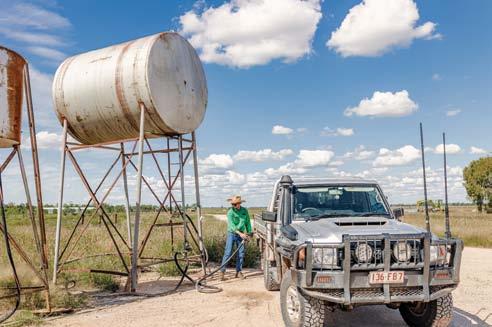
But, to quote Bob Dylon ’The times they are a-changin’ thanks to Ms Bunn’s new advanced weather forecast system specifically designed with the agricultural sector in mind. Jane’s Weather PRO can help farmers miti-
gate risk and take advantage of the weather by harnessing Artificial Intelligence (AI) to unlock weather insights and steer decisions around frost, spraying, irrigation and growth.
SENDING
HITS MARKET page 7 TITLE TO YOUNG JUDGE page 14 SOCIAL SCENE pages 24, 26 MARKET ROUNDUP .....................page 27
QCWA RECIPE page 28
SPORT page 32

Address: 154-156 Haly Street
Kingaroy 4610
Telephone: 07 4182 0450
Website: QueenslandFarmerToday.com.au
CONTACT US
Editorial:
Email: newsdesk@QueenslandFarmerToday.com.au
Advertising:
Email: advertising@QueenslandFarmerToday.com.au
Classifieds:
Phone: 07 4182 0450 or 1300 666 808
Email: sales@networkclassifieds.com.au
ADVERTISING
Samantha Wantling Sales & Marketing
E: samantha.wantling@WarwickStanthorpetoday.com.au
P: 0439 420 289
Cindy Unwin Sales & Marketing
E: cindy.unwin@CQToday.com.au
P: 0408 281 861
Jemma Wilson Sales & Marketing
E: jemma.wilson@BurnettToday.com.au
P: 07 4182 0458
Nicola Rickuss Sales & Marketing
E: nicola.rickuss@todaynewsgroup.com.au
Queensland Farmer Today is published monthly and part of the Today News Group. Published by South Burnett Today Pty Ltd ACN 641 796 349.
Publisher: Damian Morgan
Managing Director: Daniel Pelcl.
All material is copyright to South Burnett Today Pty Ltd. All significant errors will be corrected as soon as possible. For our terms and conditions please visit QueenslanFarmerToday.com.au/terms-and-conditions/
By Fiona GowersCrime Stoppers has launched a campaign to remind Queenslanders living rurally the importance of reporting farm-related crime.
The state-based campaign will employ a strategic mix of grassroots community engagement activities, local media stories and marketing activities.
Farm crime may include theft of livestock, materials such as tools, machinery or equipment, illegal hunting and fishing, illegal dumping and theft of fuel.
Crime Stoppers Queensland CEO David Hansen said sharing information about incidents or suspicious behaviour allowed the community to help law enforcement address these issues more effectively.
“It’s this momentum and increase in understanding that will support the long-term challenges associated with under-reporting farmrelated crimes,” he said.
Reasons for under-reporting, according to Mr Hansen, include farmers’ resilience, a sense of futility if their evidence is inadequate and wanting to avoid issues with neighbours who may be responsible.
He said lack of data due to under-reporting made it difficult for police to allocate resources and address rural crime issues effectively.
“If you don’t report these crimes, who will? If you see something, say something. Remaining silent means criminals can continue impacting others,” Mr Hansen said.
Detective Inspector David Briese from the Queensland Police Service Rural and Stock Crime Squad said reporting criminal activity was vital to both solving and preventing crimes that affected rural communities.
“Anecdotal evidence suggests that rural crime is under-reported,” Mr Briese said.
“The issue with unreported crime is that we cannot fully appreciate or respond to it.
“It’s also an issue when the crime is reported late as we cannot then utilise our resources in a timely way providing the criminals responsible with opportunity to cover their tracks and avoid detection.
“We need the rural community to work with us and to report what has happened as soon as they become aware of it.
“Your information could be what helps identify the people involved in rural crime activity and prevent further offences from occurring.“
Crime Stoppers Queensland, with support

from AgForce Queensland and the Queensland Police Service, will also work to establish a Rural Crime Advisory Group (RCAG).
The RCAG will help communicate how crime is impacting rural communities and help connect support providers with victims of crime.
This initiative from Crime Stoppers Queensland marks the beginning of a longterm approach, requiring ongoing effort and solutions.
It sets the stage for sustained engagement with rural farmers and an ongoing commitment to support the wider community.
“Strategies discussed include involving the Country Women’s Association, businesses such as hotels, agronomists who regularly interact with farmers and putting messages on beer coasters to help spread the word,“ Mr Hansen said.
Rural crime costs the Australian economy millions of dollars each year, with anecdotal evidence suggesting many farmers who experience rural crime are repeat victims.
· To report a crime call 131 444.
· For all anonymous reporting of crime and suspicious activity, contact Crime Stoppers Queensland on 1800 333 000 or www. crimestoppersqld.com.au/make-a-report.
The clip clop sound of horses hoovesand the kaching sound of cash registers - will ring through Chinchilla this month when the “melon capital” of Australia hosts the 2024 Australian Polocrosse Nationals.
In all, 40 top-tier teams from Queensland, NSW,Victoria, the Northern Territory and West Australia will vie for the prestigious title of “best in Australia”.
The biennial event starts on 24 June.
Chinchilla Australian Polocrosse Nationals organising committee chair John Mullins told Queensland Farmer Today he was excited to bring this elite level of competition to the Western Downs region.
“To have the opportunity to showcase the best our sport has to offer to our local community and to showcase our region to the polocrosse community is a huge honour,” said Mr Mullins who has played polocrosse for 43 years.
“Our club, which has about 80 active club members, is working very hard to ensure that this is the best Nationals to date.“
The polocrosse tournament will follow a pretty standard formula, with Chinchilla adding its own personality through live music, a mix of evening enterntainment and formal player presentation dinners for both seniors and juniors.
“We’ve been going to the Nationals for quite a few years and taking notes,” Mr Mullins said.
“And (while) there’s certain protocol that you have to follow, there’s a lot of things you can do to make your event stand out from the crowd.“
* The 2024 Chinchilla Australian Polocrosse Nationals will be held at the Chinchilla Polocrosse Grounds (115 Racecourse Road, Chinchilla) from 24 to 30 June.
 - Fiona Gowers
- Fiona Gowers
Popular weather presenter Jane Bunn reads the weather and, importantly, she understands it. Her inside knowledge is now helping farmers on the Darling Downs master the skies above.
Receiving accurate, localised forecasts has long been difficult with farmers often forced to decipher the outlook from multiple weather sites and apps.
But, to quote Bob Dylon ’The times they are a-changin’ thanks to Ms Bunn’s new advanced weather forecast system specifically designed with the agricultural sector in mind.
Jane’s Weather PRO can help farmers mitigate risk and take advantage of the weather by harnessing Artificial Intelligence (AI) to unlock weather insights and steer decisions around frost, spraying, irrigation and growth.
The tech was developed by Ms Bunn, a meteorologist and 7NEWS Melbourne weather presenter who was among the innovators showcasing their creations at the Agtech and Logistics Hub’s 2023 GroundUp Agtech Showcase Day.
The event provided valuable industry connections and feedback and, since then, Ms Bunn has further progressed her advanced weather forecasting system by utilising AI and machine learning.
With Jane’s Weather PRO officially released in May, the Agtech and Logistics Hub is introducing Jane’s Weather team to farmers in the Darling Downs region who can access hyperlocal forecasting with hourly predictions.
Josh Cross of Jane’s Weather said the Darling Downs region had traditionally relied on generic guidance from the Bureau of Meteorology and various other sources.
“In the Darling Downs, we can offer farmers a more accurate and localised forecast than what they’ve been used to,” Mr Cross said.
“Jane’s Weather has created a single source of truth.
“No more deciphering your outlook from multiple weather sites and apps, this cuttingedge technology combines all the guidance and learns your specific microclimate, so the latest in AI can provide the best outlook - for your actual farm.
“It can even be set up to consider observations from on-farm weather stations.”
Jane’s Weather PRO also allows users to set custom threshold weather alerts relevant to their operations, enabling better planning and decision-making around crop and pasture management.
While developing the PRO system, Jane’s Weather tested its usability and accuracy with several major agribusinesses, including growers and spray contractors.
Mr Cross said farmers could use Jane’s Weather to identify ideal spraying windows, determine optimal fertiliser timing, prioritise sowing orders, better manage water resources, improve logistics planning at harvest to maximise yields and more.
“The system empowers farmers with informed decision-making capabilities, providing accurate, hyper-local and hourly weather

forecasting crucial to their operations,” he said.
Mulgowie Fresh Agronomy manager Andrew Johanson said the technology had significant potential.
“Having access to accurate, site-specific weather information will enable growers to make timely decisions that can positively impact our crop yield and quality,“ he said.
“This is a major advancement for the horticulture industry and it’s exciting to be a part of it.“
Agtech and Logistics Hub manager Owen Williams said the agricultural sector could benefit greatly from more accurate and local weather forecasts.
“Weather plays such a critical role in producing high-quality crops and livestock, so it’s great to see an Australian-founded technology focused on improving localised forecasts and providing tailored weather insights,” he said.
“We look forward to seeing Jane’s Weather continue its innovation journey and mission to get their tech into the hands of farmers.”

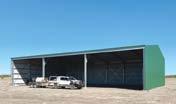
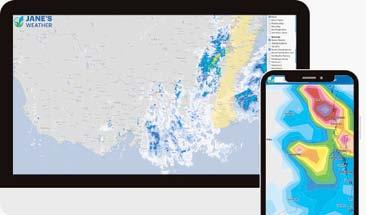

A soft pink glow lights the faces of enthusiastic students dressed in white lab coats as they study plants growing in purpose-built grow boxes destined for space stations.
Secondary students united at La Trobe University in April for the Plants for Space immersion day.
In this national project, students in years seven to 10 grow plants in controlled conditions to test their suitability for NASA missions, with the aim of helping to feed a crew of hungry astronauts.
Students’ results will then determine the most nutritious plants for space travel.
Dr Frazer Thorpe, La Trobe University Animal Plant and Soil Sciences educational and engagement manager said the initiative complemented the Australian curriculum and gave students a unique introduction to gardening through science.
He said the project’s premise was to create “zero waste” plant resources on demand that thrived in space.
“All of that knowledge is then going to be brought back to Earth and be really useful for sustainable farming,” Dr Frazer said.
“This whole project is about growing plants in enclosed environments.
The use of chemicals, fertilisers, nutrients and lighting. It’s about increasing productivity in enclosed environments.”
Dr Thorpe said astronauts on the International Space Station relied on a pre-packaged
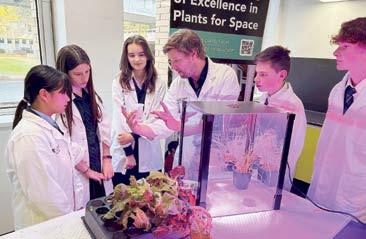
diet that was frequently replenished via food drops.
But, in the long term, space gardens providing fresh, edible plants would sustain astronaut health and wellbeing.
In Plants for Space, students build the “growth habitat” inside a box the size of a large
microwave fitted with LED lights and sensors.
Then they plant the seeds of a leafy green called misome, which grows reliably and quickly – both on and off-Earth.
Students gain valuable experience running their own experiments, including planting the seeds in pots and using growth media that
match the NASA Vegetable Production System (Veggie).
They monitor growth and water use, making notes about plant size, colour and fitness. Students learn what plants need, how fast they can grow, what can be recycled and how much can be harvested. Also, does anyone want to eat it?
Dr Frazer said Plants For Space was linked to the Australian curriculum through “science as a human endeavour”.
This related to the role of science in society, including how scientific knowledge influenced people’s lives and could be used to make decisions.
He said another important part of the project was the emotional connection with nature that promoted interest in learning about sustainability and, in turn, caring for natural resources.
“I am trying to ensure that the students of today have the skills and knowledge in which they can see science as a potential career choice,” Dr Frazer said.
“And the way I’m doing that is by supporting the teachers and providing these kind of curriculum-aligned, curriculum-enriched activities that supports what the teachers are doing.
“So, my real passion is making sure we can support the teachers to be able to support the students and, in turn, support society.”
Students from the Lockyer have embarked on a trip of a lifetime as part of the Australian Future Farmers Exchange (AFFE).
Declyn Cable, Brooklyn Friels, Sophie Radke, William Nielsen and Emily Markwell, who attend Faith Lutheran College, are in Victoria broadening their farming experiences and seeing the opportunities in the agriculture industries.
The Australian Future Farmers Exchange - the brainchild of Lockyer resident and educator Russell Berlin and co-founder Amanda Naish - aims to address the critical challenge of an ageing farming population and the widening gap between young individuals and the agricultural sector.
“This initiative not only shows students the realities of farming and agricultural business but also fosters connections with industry professionals, potentially guiding their future career paths,” Mr Berlin said.
“Our goal is to empower the next generation with the skills, knowledge and enthusiasm for agriculture.”
As part of the exchange, the Lockyer students will see first hand new farming systems
and careers in viticulture, beef production, boutique farming enterprises and tourism in north west Victoria.
It is a trip of a lifetime for Emily Markwell who, thanks to her involvement through her school and AFFE, has her sights set on a future in the agriculture business.
“I’m looking forward to travelling outside the region and exploring the different aspects of agriculture and the opportunities,” Emily said.
“For me, agriculture is about hard work and teamwork. I want to travel to Australia to help on farms and learn more.”
Member for Lockyer Jim McDonald said calling the Lockyer Valley home, a region rated among the top 10 most fertile farming areas in the world, was an excellent start for a future in agriculture.
“Our farming future lies in this next generation’s hands and it is wonderful to see the opportunities the program gives these students,” Mr McDonald said.
“Congratulations to the students involved for putting their hand up to try it and learn more — the future of farming is an innovative and exciting space.
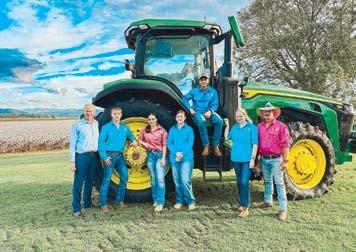

India has suspended tariffs on Desi chickpeas.
Grains Australia has welcomed the decision, saying it was “a great outcome“ for both Australia and the Indian pulse market.
“This welcome decision by the Indian Government shows the value of continued, respectful government and industry engagement with a highly-valued trading partner,” Grains Australia Pulse Council chairman Peter Wilson said.
In May, the Indian Government suspended the tariffs that had been equivalent to about 66 per cent, with the decision effective until 31 March, 2025.
India introduced tariffs on chickpeas initially equating to 33pc in 2017/2018, effectively eliminating Australian chickpea exports into India - the world’s biggest consumer of chickpeas.
Mr Wilson said the suspension of the tariffs was likely to deliver more reliable pricing for Australian chickpeas and add depth to already solid markets.
“It will increase competition for Australian chickpeas that are already exported into other important markets including Bangladesh, the United Arab Emirates and Pakistan,” he said.
Grains Australia general manager trade and market access John Ackerman said Grains Australia, in collaboration wth industry and government, looked forward to working with the Indian Government to build on the important development.
“It is a wonderful opportunity and we will be focused on ensuring we are meeting the

needs of our chickpea markets, including supplying an affordable, high quality product,” Dr Ackerman said.
Grains Australia, with support from the Australian Government, was represented in New Delhi earlier this year at ‘Pulses 2024’, the annual conference of the Global Pulse Confederation and a major event on the global pulse calendar.
The event provided opportunities to communicate with Indian government and industry representatives.
A brochure, Australian Pulses – Partnering with India was produced for the conference outlining details of Australia’s valued pulse trading relationship with India.
Grains Australia is an initiative of the Grains Research and Development Corporation (GRDC) and is responsible for vital industry services and functions that improve the industry’s competitiveness and profitability.
GrainsAustraliaPulseCouncilchairmanPeter Wilson. Picture:SUPPLIED
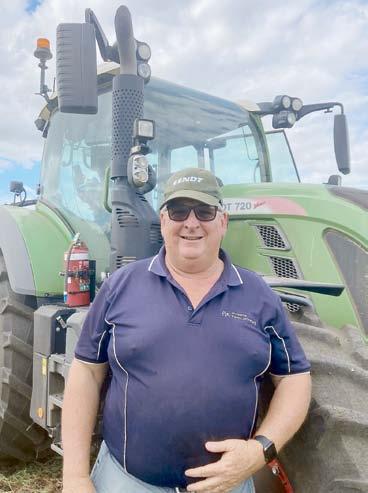

Australian farmland prices are set for further growth in the year ahead – but at a slowing pace – Rabobank says in its just-released annual Australian Farmland Price Outlook.
The global agribusiness banking specialist says after three consecutive years of “double digit” growth, the momentum in agricultural land price increases is expected to further slow in 2024, as farm profitability levels come off record highs.
And the price outlook is mixed across sector types and geographical regions, the bank says.
Rabobank is forecasting a “base case” increase of about five per cent in the median price per hectare of all agricultural land types nationally in the year ahead.
“Land prices will maintain their growth trend, but not for all sectors and regions,” the report says.
The bank’s analysis showed while the median price of agricultural land per hectare nationwide grew at a rate of 10.9 per cent in 2023, this was down on the stellar growth rates of 28.6pc and 27pc seen in 2022 and 2023 respectively.
Report author, RaboResearch analyst Vitor Pistoia said this slowing growth trend in agricultural land prices reflected a “maturing land market”, with a less bullish outlook for farm profitability, along with weather challenges and a tighter supply of available properties.
“Australia’s farming sector experienced an unprecedented positive cycle from 2020 to early 2023. Record-high commodity prices and plentiful rainfall supported profitability, which boosted farm business equity and confidence in a brighter future,” he said.
“Outside investors joined this booming sector and turbo-charged competition for land, supported by low interest rates.
“The land market suddenly had many participants bidding – farmers willing to expand, investors pursuing capital gains and companies looking to invest in the carbon
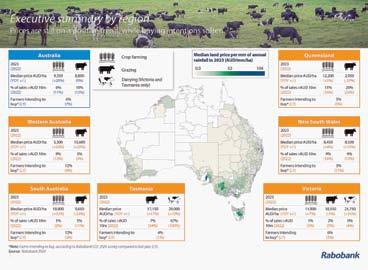
RabobankAustralianfarmlandpriceoutlook2024.
credit sector.”
On the flipside, Mr Pistoia said, farmers willing to exit the industry had used the opportunity to sell at rising prices, adding to the supply of land available for the increased demand.
Now, he said, the agricultural land market was finishing this cycle and starting a new one, where the number of farms for sale and bidders is lower and the financial outlook for the sector, while overall strong, is not as positive.
The report says while the outlook for key drivers of agricultural land values – including production volumes, commodity prices and farm income – are still promising for 2024/25,

the “upsides are diminishing” compared with recent years.
And interest rates remain an elevated cost, with further increases considered likely and no relief in sight.
“Some regions might see a decline in winter crop production on the back of a dry start of the season,” Mr Pistoia said.
“But the chance of a La Nina in the second half of 2024 offers a potential tailwind for cropping operations. Beef production is poised to expand on the back of good rains in large swathes of northern Australia.
“Commodity prices are still slightly above

historical averages for a number of sectors, albeit down from record highs seen in recent years. Improved cattle prices and a better market outlook also mean grazing land should partially recover its price growth pace.”
The longer-term outlook for agricultural land prices – for 2024 to 2029 – indicates a further slowing, the report said, with a gradual reduction in price growth, as buyers seek the “best value for money”.
“The number of deals based on capital gains rather than economic fundamentals may dwindle as the market matures,” Mr Pistoia said.
But the forecast is still optimistic.
“The long-term view is crystal clear – farmland is in demand,” he said, “The pivotal point for the land market now is how to properly evaluate the ‘risk-reward’ scenario for such a long-term investment.”
And while the growth rate in agricultural land prices is slowing, Rabobank does not foresee a drop in land values in its forecast.
“A drop in land values would require widespread drought, serious economic hurdles and/or disease outbreak – none of which is on the horizon fortunately,” the report says.
Authorities are concerned after fire ants were again found well outside Queensland’s containment zone.
More fire ant nests have been found west of the Great Dividing Range as the highly aggressive super pest invades new islands off Brisbane. Australia is waging a long and costly war to eradicate the invasive species, which has profoundly affected agriculture, wildlife and people in other countries. But there’s mounting concern over a series of recent detections outside a biosecurity containment zone, centred on Queensland’s southeast corner.
On Friday 17 May, authorities said two nests had been found at Meringandan West in Toowoomba - about 4km from Kleinton, where two nests were found in 2023. The Meringandan West discovery is about 10km from an army site at Oakey where almost 80 nests were found in April, but authorities say the discoveries are not linked. The Oakey detection was the first in the Murray Darling Basin, which ecologists and farmers have long feared because fire ants can join together to form rafts and harness river flows to invade new areas.

Fire ants have also recently been detected in NSW at South Murwillumbah and Wardell, south of Ballina, with those infestations stamped out. But authorities remain on high alert. The National Fire Ant Eradication Program says it destroyed the nests found by its odour detection dog team at MeringandanWest on Tuesday.
“The team was in the area conducting surveillance as part of compliance tracing activities. The tracing is not linked to the recent detection in Oakey,” the program said on Friday.
Meanwhile, there have been new detections on the Moreton Bay islands, off Brisbane.
They were found on Coochiemudlo Island and South Stradbroke Island in April, and on Russell Island in February.
That follows discoveries on North Stradbroke Island and Macleay Island in 2023.
The eradication program says all detected nests have been treated along with surrounding areas, but residents must be vigilant given what’s at stake for the environment, the economy and Australia’s way of life. Earlier in 2024, the federal environment department warned that if fire ants became established across Australia, they would surpass the combined effects of feral cats, feral pigs, dogs, foxes, camels, rabbits and cane toads. It warned 97 per cent of the country could be invaded by the hyper-aggressive ants, which work together to swarm and kill their prey and defeat anything that disturbs their nests. Annual losses for Australia could reach $2 billion a year.
In other parts of the world, including China and the United States, fire ants have overrun ecosystems and changed them forever.
A risk assessment of about 120 wildlife species in Queensland’s southeast found fire ants are likely to have effects severe enough to cause population declines in 45 per cent of birds, 38 per cent of mammals, 69 per cent of reptiles and 95 per cent of amphibians. Fire ants can spread naturally but human assisted movement, particularly in organic materials such as soil, mulch and turf, is a major risk when it comes to helping them move large distances. The eradication program has urged everyone to look for and report fire ants, which are copper brown in colour and have a darker abdomen.
They are two to six millimetres long, with a variety of sizes found in each nest.
Nests appear as mounds or patches of loose soil and have no obvious entry or exit holes.
Nationals Leader David Littleproud has his say on page 31
Southern Queensland beef cattle enterprise Burnbrae has hit the market for the first time since the holding was drawn 57 years ago.
Held by the Campbell family since establishment, the 2500-plus hectare Moonie property is expected to hold particular appeal for existing industry participants and family farming groups.
There is no price guide, but recent sales in the area have achieved rates in the vicinity of $1900 to $2000 per acre.
JLL Agribusiness senior director Geoff Warriner is exclusively handling the sale with fellow senior director Chris Holgar, director Clayton Smith and executive James Mitchell.
He said it was an opportunity to secure a turnkey enterprise on a single freehold Certificate of Title and within a commodity sector that was rebounding.
“The property has just had one of its best seasons in recent times and is fully grassed up,” Mr Warriner said, pointing to optimistic sector forecasts generated by recent rains.“
In what was historically a tightly held area, JLL has brokered four local sales during the past couple of years with a combined value more than $50 million.
“These were driven primarily by succession planning and transfer to the next generation.”
Mr Warriner said while the property was suitable for conversion, it currently operated as a beef cattle breeding and backgrounding enterprise, with progeny turned-off at feedlot specification.
“Burnbrae has been practically designed, with modern livestock-handling facilities fed by a central laneway linking the 17 paddocks across the holding,” he said.
“Production is further enhanced through arable areas, of which the majority of the property has been farmed historically and with 73 hectares currently planted as oats.”
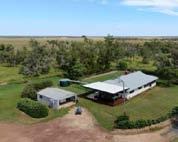
Infrastructure across the property includes a homestead, registered artesian bore, 20 megalitre surface dam, concreted workshop, shearing shed, hay shed, grain silos and galvanised steel stock yards with a comfortable 300-head capacity and all-weather access to the Moonie Highway.
Mr Holgar noted the property’s location –14 kilometres from Moonie and 100km from Dalby – was expected to be a key driver of appeal.
“Burnbrae is ideally positioned between Roma and Dalby, which serve as two of Queensland’s major livestock selling centres,”
Mr Holgar said.
“Its direct frontage to the Moonie Highway affords easy access to multiple end markets, including processing facilities, sales yard and also multiple feedlots sitting within a 150km radius.
“It also has access to service centres and the full array of amenities including health, medical, entertainment and educational facilities.”
The expressions of interest campaign will close on 6 June, at 4pm.

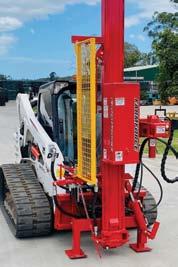

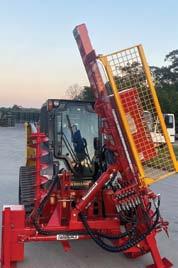

Queensland is Australia’s cheese and ice cream capital.
The Sunshine State dominated the field in the hunt for the nation’s finest produce at the Brisbane Showgrounds in May.
Australia’s best beef, lamb, cheese, dairy, ice cream, gelato, sorbet, barramundi and prawns were crowned from a total of 465 entries, in the RNA’s prestigious Royal Queensland Awards.
Blackall Gold Washed Rind, produced by the Sunshine Coast’s Woombye Cheese, was named Australia’s best cheese while Wicked Ice Cream from Port Douglas clinched the title of Australia’s best ice cream for their Coconut Delight sorbet.
Chief judge of the Royal Queensland Cheese and Dairy awards and Royal Queensland Ice Cream, Gelato and Sorbet awards Russell Smith said the standard of entries in the ice cream competition was “exceptional“ and “world-class“.
“The winning Coconut Delight sorbet from Wicked Ice Cream is just superb,“ he said. “It has a beautiful balance of flavours between the freshness of the coconut and the underlying salt level.“
Mr Smith said Woombye Cheese’s Blackall Gold Washed Rind was the cheesemaker’s best yet.
“Woombye Cheese was the Grand Champion back in 2022 and they have reclaimed the title this year because their washed rind entry boasts exactly the flavour profile we are looking for in this style of cheese,” he said.
Chief Judge of the Royal Queensland Branded Beef and Lamb awards Elaine Millar said the beef competition, won by Andrews Meat Industries from Lidcombe, New South Wales, provided a magnificent judging experience across all classes.
“The exceptional beef entries reinforce Australia’s position as a leader in the international beef market,” she said.

Ms Millar said Tasmanian-sourced lamb was proving tough to beat with producers from the state winning Grand Champion Branded Lamb of Show in 2022, 2023 and 2024.
“Australia’s best lamb for 2024, Tasmanian Quality Meats Trade Lamb, delivered superb rich complex flavours and fine pate`-like textures, resulting in a generous mouthfeel.
“The stunning juiciness and tenderness are obviously the result of the superb mar-

Showcasing our young female leaders
bling throughout.
“Our retail and food service industries and, ultimately, the end diner are the beneficiaries of Australia’s dedicated beef and lamb producers who continue to excel within a diversity of regions and breeds of cattle.”
Entries in the Branded Beef and Lamb competitions were up 21 per cent on last year.
Chief Judge of the inaugural Royal Aquaculture awards John Susman said the introduc-
tion of the new competition celebrated excellence in one of the fastest growing sectors of agribusiness.
“The Aquaculture awards launched with the Farmed Prawn and Barramundi classes and the winning entries underwent a rigorous assessment based on quality, flavour and presentation,” he said.
“The competition honours the efforts of aquaculture farmers from around Australia and we are looking to grow it in future years with the planned introduction of other farmed fish varieties.”
Some of the award-winning products will be showcased on the Royal Queensland Cooking Stage at the 2024 Royal Queensland Show (Ekka).
GRAND CHAMPION BRANDED BEEF OF SHOW (Australia’s best steak)
· W Black by Andrews Meat Industries
CHAMPION BRANDED LAMB OF SHOW (Australia’s best lamb)
· Tasmanian Quality Meats Trade Lamb by Tasmanian Quality Meats
GRAND CHAMPION DAIRY PRODUCT OF SHOW (Australia’s best cheese)
· Blackall Gold Washed Rind by Woombye Cheese
GRAND CHAMPION ICE CREAM, GELATO OR SORBET OF SHOW (Australia’s best ice cream)
· Coconut Delight by Wicked Ice Cream CHAMPION MSA GRADED BRANDED BEEF OF SHOW
· Portoro, Marble Score 4+ by JBS Australia AQUACULTURE TROPHY WINNERS
Champion Barramundi of Show
· Coral Coast Barramundi by GFB Fisheries Champion Tiger Prawn of Show
· Fresh Tiger Prawns by Australian Prawn Farms.
Rural generalists are overlooked, they sayBy Sophie Mossman
With the Federal Government’s budget announcement, it is becoming more evident that the rural generalist as a health profession is being phased out.
To regional and rural communities, Rural Generalists are much more than just their local doctor, they are core community members and are once again not getting the support they need to continue caring for their local patients.
This is nothing new as health services in such areas have been underresourced and understaffed for decades, leading to patients often travelling hundreds of kilometres to get the care they need or even a consult.
 Picture: JULIAN SMITH/AAP
Picture: JULIAN SMITH/AAP
Are you a young woman who aspires to leadership?
Rockhampton Agricultural Show is seeking young women to represent their region.
Enter online today
AMA Queensland Vice-president, Dr Nick Yim who is also a GP in Hervey Bay said the key to recruiting and retaining rural generalists is increased funding to help create strong support networks for them.
“The big thing we are seeing is now many of our doctors see a big importance of self-care; gone are the days where you hear doctors working 60, 70 or even 80 hours a week,” Dr Yim said.
“AMA Queensland is calling for a workforce plan from the state government to find out where the deficiencies of numbers are; we know that one full-time equivalent doctor may not mean one doctor, it might mean two doctors.
“We also need to see what the deficiencies are from a training position perspective.”
Before last week’s budget announcement, the Australian College of Rural and Remote Medicine (ACRRM) submitted a proposal to invest in rural generalist-specific Medicare items.
This proposal aimed to promote ru-
ral generalism as a profession, train 500 ACRRM registrars annually for the next five years and enhance ties with universities to provide scholarships for medical students taking the path of RG.
Instead, this perfectly good starting point to tackle this ongoing problem at its roots has been overlooked.
National Rural Health Alliance chairperson Nicole O’Reilly said people living in rural areas are nearly three times more likely to die from avoidable causes than those in metropolitan areas.
“It is disheartening to observe the government’s lack of responsiveness to rural voices and its failure to commit to comprehensive reforms that would offer sustainable and long-term benefits for rural communities,“ Ms O’Reilly said.
“Funding could have enabled rural Australians to access health and medical services in their local communities.
“There is much more to be done to address the inequity in health care outcomes for rural and remote Australians.”
International students and overseas workers could still move to Australia’s regions even if the opposition attempts to free up housing supply by slashing migration.
Opposition Leader Peter Dutton has promised that if elected in 2025, a coalition government would introduce a two-year ban on foreigners buying existing homes, cut the number of international students and reduce overseas net migration from 260,000 to 160,000.
The government would need to increase supply by leveraging existing homes - something Mr Dutton said would free up more than 100,000 homes in the next five years.
Asked if the cut to migration numbers would hurt the regions, Nationals leader David Littleproud said the plan would address the nation’s pressure points while acknowledging economic necessities.
“This is about making the tough decisions that prioritise where the economy needs the support to continue to grow - and particularly in the regions,” he said.
For example, Mr Littleproud said he would work with the Liberal Party to ensure regional universities that relied heavily on international students continued receiving student numbers and support.
The coalition would also set up an agriculture visa that would allow migrants to work in regional Australia in both farming jobs and periphery roles.
“They simply don’t have the labour force without them,” Mr Littleproud said.
But Treasurer Jim Chalmers says the opposition’s plan would divide the Australian community and hurt the economy.
“His budget reply was dark, it was divisiveintentionally so - and the net effect of all that would be that he would destroy the budget and damage the economy,” he told the ABC News.
Dr Chalmers said the government’s plan to halve net overseas migration and reduce permanent migration was created with the economy and skills base in mind.
The coalition is also pushing for Australians to be allowed to withdraw up to 40 per cent of their superannuation - to a maximum of $50,000 - to buy their first home.
The proposal has been criticised by econo-
Coles and Woolworths have been grilled by Queensland Premier Steven Miles after he made a surprise appearance at a supermarket pricing inquiry in midMay.
Woolworths has been challenged by a premier to apologise to families doing it tough during the cost-of-living crisis.
Steven Miles has also rebuked Australia’s other supermarket supremo, Coles, for a perceived lack of contrition amid concerns the two retailers are not taking a parliamentary inquiry into the matter seriously.
The Queensland premier made a surprise appearance at the supermarket pricing probe in Brisbane on Monday 13 May, firing questions at the grocery giants.
Seizing the opportunity to extract answers, Mr Miles asked Woolworths chief commercial officer Paul Harker if he would apologise to families forced to reduce their fresh food consumption because of price increases.
“I certainly have empathy and will we seek to do more for consumers? Yes, we will,” Mr Harker said. “But I don’t believe we’ve done anything wrong.”
Mr Miles took Coles to task, asking public affairs head Adam Fitzgibbons whether there was anything the company could have done better during the past six months.
The inquiry will hand down its report at the end of May.
mists and the superannuation industry, who said it would push up house prices, put retirees with mortgages at risk, and not benefit young Australians and renters.
Mr Littleproud defended the plan as one part of a broader policy.
“It’s about buying time to increase supply and also giving that hope to young people that one day they might actually own their home,” he said.
The federal and state governments have committed to building 1.2 million well-located homes but a report from the governmentappointed National Housing Supply and Affordability Council found the Commonwealth would fall short by hundreds of thousands.
Mr Dutton’s budget reply speech also emphasised the role nuclear power should play in Australia’s future energy policy, without providing detail on where small modular reactors might be located.
The Nationals leader said further information about six or seven locations would soon be revealed, but Prime Minister Anthony Albanese has criticised the energy plan.
“This is a shocking policy,” he told reporters north of Sydney on Sunday.
“In the best case scenario, they have no financing and will require massive subsidies up front.
“We’ll go back to nothing happening when what we need is additional energy supply.”







Dairy farmers and graziers are urged to inspect their crops amid fall armyworm (FAW) infestations in forage oats across southern-growing regions.
Reports of FAW impacting oats have surfaced from regions including the inner Downs, Southern Downs, Western Downs and Rolleston in central Queensland.
“Emerging and establishing crops are at greatest risk of complete defoliation and plant death,” Department of Agriculture and Fisheries principal entomologist Dr Melina Miles said.
“Growers and agronomists are encouraged to check crops for evidence of FAW within seven to 10 days of emergence.
“In oat–pasture mixes you may see damage to grasses and broadleaf pasture species when the FAW have consumed the oats and move as larger larvae.”
These infestations come at the end of the most severe season since the pest arrived in Australia in 2020.
If Queensland experiences a mild autumn, FAW activity in winter crops and pastures is expected to persist, but the rate of damage will slow as average temperatures decline.
Emerging and establishing crops are at greatest risk of complete defoliation and plant death.
Crop-checking intervals of seven to 10 days will avoid damaging infestations going undetected.
Look for windows or holes in leaves where small larvae have fed, or evidence of more substantial feeding with tillers cut off and plants completely eaten.
Bare patches in the paddocks and dying plants are indicative of more severe infestations.
Don’t rely just on finding damage — pull up damaged plants and confirm the presence of larvae (caterpillars).
Medium and large larvae may shelter under the soil surface at the base of plants during the day.
Carefully inspect the soil around the base of damaged plants. Damage to stems by these larger larvae can result in plant death from dehydration or disease.
Once larvae are 20mm long they will cause significant damage in a short period of time. Timely detection is crucial to minimise losses and safeguard yields.
If FAW is detected, growers should seek

support from their local agronomist.
Further information: Resources on identification of FAW and symptoms of damage to
Cotton Australia (CA) has launched a creative new competition that invites entrants to take unique photographs showcasing their experiences and dispel myths surrounding cotton production, community life, innovation and the growers themselves.
The Click 24 Competition aims to empower growers and their regional communities through the lens of photography, thereby providing participants with an opportunity to open a public window to their farming life.
Contest organiser and CA communications manager – digital Desley Sheedy said the photo competition was for growers, community members and those involved in agriculture.
She said it encouraged them to delve deep into the heart of the industry and cotton growing communities, highlighting the dedication, hard work and innovation that defines modern cotton production.
“Categories are based on the Australian Cotton Sustainability Framework pillars; Planet, People, Paddock and a ‘wildcard’ category where entrants are encouraged to take a photo that challenges misconceptions about the cotton industry.
“Or, (where the photo) tells a story about living and working in rural Australia that the public may not know about.
“Participants have the chance to win a total prize pool of $7000 and category finalists
will have their photos put on display at the upcoming Australian Cotton Conference on the Gold Coast where a people’s choice winner will be judged.”
Prizes include:
· Overall first place winner: $2500 voucher –voucher from Camera House, JB HiFi or a Qantas travel voucher.
· Runner Up: $1500 voucher – voucher from Camera House, JB HiFi or a Qantas travel voucher.
· People’s Choice: $1000 voucher from one of our Australian Cotton brand partners: Country Road, RB Sellars, Sheridan or RM Williams.
· Category winners: $2000 (4 x 500) vouchers – choice of voucher from one of our Australian Cotton brand partners: Country Road, RB Sellars, Sheridan or RM Williams. CA CEO Adam Kay encourages entries from across the industry and beyond.
“For growers, this competition represents an opportunity to shape the narrative surrounding their livelihoods and offer an authentic glimpse into the reality of cotton farming.”
For more information on how to enter and competition guidelines visit the Cotton Australia website.
Cotton Australia is the peak representative body for Australia’s cotton growing industry.
oats and other crops are available onThe Beatsheet (www.thebeatsheet.com.au).
If you think you’ve seen fall armyworm, call your local agronomist or contact the Department of Agriculture and Fisheries on 13 25 23 or visit daf.qld.gov.au
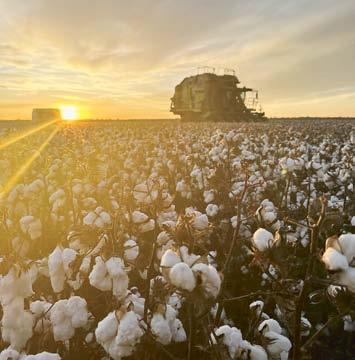
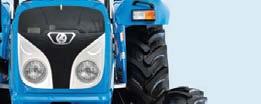








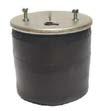

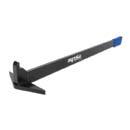




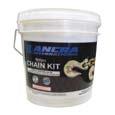
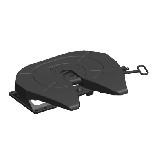

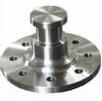

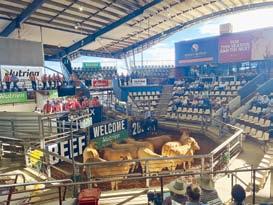
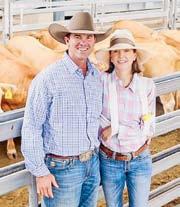

Beef2024 kicked off on Sunday 5 May the Nutrien Ag Solutions Commercial Cattle Championships with competitors Cliff and Sasha Mylrea of Needmor Cattle Co taking home the Grand Champion title with their pen of 10 Droughtmaster steers.
Fed at Barmount Feedlot for 127 days, the pen on average weighed 704 kilograms and was HGP-treated.
The champion pen won Class Two in the competition, which required to be 640 to 704 kilograms, with a maximum of four teeth, a minimum of 100 days grain-fed and suitable for the export market.
Held at CQLX Gracemere Saleyards, the competition was judged by Craig Price and Glenn Poole.
“We are over the moon to take home the grand champion rosette,” Mr Mylrea said.
“We’ve been entering a lot of cattle competitions, but Beef2024 in particular, for a long time and this is the first time we’ve won the champion pen, so it’s really good and we’re proud of them.”
The family’s success has continued since 2021 with their champion pen of lot-fed heifers and champion pen of crop or pasture-fed steers.
“It was a dry year last year and we were very close to not having them here,” Mr Mylrea said.
“You’ve got to carry them from when you wean them through to that feedlot weight and there was a decision to be made about whether we sold them to make room for our cows, or hang onto them.
“Fortunately, the season has turned around and the decision has paid off.”
Mac and Gayle Shann, Cantaur Park, Clermont also took home the champion title for their pen of 10 Droughtmaster/Charolaiscross heifers.
The champion pen of heifers won first

place in Class Five weighed on average 578 kilograms, and is HGP-treated.
Mr Shann said they are very proud to be in the first row where the champions are.
“A lot of time, effort and dollars go into it, but it’s a magnificent result,” he said.
“We have a line of Droughtmaster breeders that we cross with Charolais bulls and they’re a
cross we particularly love.
“We put two pens together for this class and we’re very, very happy with these girls, but you never know until the day you get here.”
Q: What weighs 10 times as much as the world’s tallest building?
A: The amount of fertiliser used by Aussie farmers each year.
Yep, around five million tonnes of fertiliser is applied to agriculture land across the continent annually.
And, while cattle and sheep account for most of our sector’s greenhouse gas emissions, fertiliser, mainly nitrogen fertiliser, is also a major contributor.
Once applied to agricultural land, this type of fertiliser can lead to the release of nitrous oxide, an active greenhouse gas that is particularly good at trapping heat in the atmosphere. In fact, nitrous oxide is 265 times more potent than carbon dioxide when it comes to global warming, according to the CSIRO. And it is responsible for about 15 per cent of emissions in Australian agriculture.
It’s not only the use of fertiliser that is emissions-intensive; the production side is also culpable. The manufacture of nitrogen

fertilisers requires high temperatures, typically generated by fossil fuels.
Already, we are seeing several countries looking to place limits on nitrogen fertiliser use in agriculture, including Canada, New Zealand and the Netherlands.
But reducing fertiliser generated emissions is not as simple as cutting down on usage.
Fertilisers are essential for providing nutrients, particularly nitrogen, phosphorus, and potassium, for plants, in turn reducing soil erosion.
With pressure to remain highly productive
while also reducing reliance on chemical fertilisers, the transition from synthetic fertilisers to more environmentally friendly alternatives is well underway in Australia. A host of innovative, natural yet effective solutions are emerging.
Our current Grains Research and Development Corporation (GRDC) supported GroundUp accelerator program includes a host of innovators who have developed organic solutions that can deliver improved soil and crops.
For example, there’s Metagen, with its DIGESTOR product, reducing reliance on nitrogen and phosphorous inputs by significantly improving the efficiency of these resources already present in the soil. It specifically stimulates indigenous soil biology, increasing the activity of microbes responsible for nitrogen fixation, cycling and phosphorus solubilisation.
UK-based innovator Messium has developed a nitrogen concentration estimation system that delivers fertiliser savings. Its sat-
ellite Nitrogen Estimator delivers valuable insights on nitrogen concentration levels in wheat, enabling farmers to make substantial savings in annual fertiliser costs.
Another GroundUp participant, MADE, offers locally produced biofertilisers and biofuels that reduce farmers’ reliance on synthetic fertilisers while improving yields and reducing costs through improved soil health. Its high-quality digestate-based biofertilisers are tailored to plant needs, soil and climate conditions, optimising nutrient management by rebalancing the soil microbiome to improve plant health and yields, build soil health and reduce disease pressures.
I can’t wait to see how these innovators’ solutions progress throughout the accelerator program, which is focused on fast-tracking these and a host of other incredible solutions for the grains sector.
* Thomas Hall is the Director of the Agtech and Logistics Hub, Australia’s home of digital agriculture.

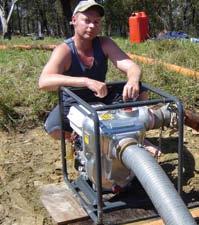
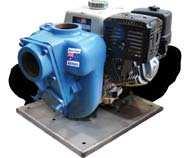

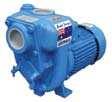

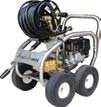


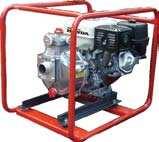
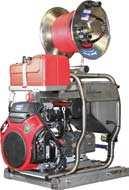


Alexandra Olive of Apis Creek Brahman Stud has been crowned as the Champion Young Judge after her astonishing performance at the Datamars Livestock Young Judges Competition at Beef2024.
The competitive line-up of beef industry ‘young guns’ aged eight through to 25 saw 18-year-old Alexandra knock out the 18 and under-25-year-old classes.
This being Alexandra’s first time on Beef’s big stage, she said it was an amazing feeling to be named Champion Young Judge.
“It’s a pinch-me moment,” she said.
“I just feel so grateful for this opportunity to showcase what I love doing and get to have my say in front of such a beautiful, big audience.”
Being the fifth-generation beef producer and third-generation of the Apis Creek Brahman Stud, Alexandra recently purchased and showed her first stud animal earlier in the week.
“I purchased NCC Ellie at the NCC sale last year and broke her in with the aspirations of competing in Paraders and implementing her into my herd,” Alex said.
“She did amazing; she’s such a little firecracker that never stops amazing me, and she’s just a beautiful heifer.”
Renowned international judge, PJ Bulder presented entrants to a masterclass of his knowledge.
Having judged 93 different cattle breeds in over 40 countries, Mr Bulder became the first to ever judge a National Show on all six continents in 2017.
Passing on his fundamental principles and critical pieces of advice to the junior judges, Mr Bulder told reporters what attributes he searched for when judging.
“There’s lots of talent and lots of future here, and it’s really exciting,” he said.
“It’s a very subjective exercise and it’s based on different objectives, resources and environments, so those of you who don’t make it through to the next round, don’t take it too seriously because I’m sure that a lot of you, if you articulated why you sorted the cattle the way you did and evaluated them the way you did, there’s good reason for that.
“I think there are a lot of people who disagree with me; this is show business, it’s not ice cream sales, so it’s not the best way to make friends.

OverjudgesJakePhillipsandStephLaycock,DatamarsLivestockYoungJudgesCompetition ChampionYoungJudgeAlexandraOlive,OverjudgePJBudler,andMarkPetersfromDatamars Australia.
“Be candid, say it as you see it, be conversational and speak about the cattle the way you would if you’re out in the pasture at home evaluating livestock.”
Full Results
· Overjudges: PJ Budler, Steph Laycock and Jake Phillips
8 Years to 11 Years
· Skye White
· Harper Will
· George Streeter
· Nathan Walter
· Samuel Ford
12 Years and 13 Years
· Imogen Land
· Ella Geddes
· Maddison McAlister
Pictures:SUPPLIED

TheDatamarsLivestockYoungJudges CompetitionatBeef2024attracteda competitiveline-upofbeefindustryyoungguns.
· Lawson Sedgman
· Jarod Mahony
14 Years
· Joshua Williams
· Rhianna McIntyre
· Amelia Miller
· Polly White
· Andy Mulchay
15 Years
· Elizabeth Lawrence
· Annaka Hanson
· Ben Kingston
· Maylee Collins
· Ava Smith
16 Years
· Hamish Genrich
· Georgia Lynch
· Angus Tomson
· Izzabella Lower
· D’Arcy Burton
17 Years
· Sam Kingston
· Ben Coney
· Ella Fort
· Georgia Buchan
· Max Humphries
18 Years and Under 25 Years
· Alexandra Olive
· Charleigh Tucker
· Alicia Trovatto
· Kiralee Streeter
· Tim Connor
The Angus Pastoral Company has sizzled their mark on Beef2024 after reconnecting with Beef Australia after developing its new ‘signature restaurant brand’ Signature Beef.
The restaurant supplied guests with quality Angus Pastoral Company meat processed through their on-farm abattoir, Signature On Farm.
Run by 40 staff, mostly Angus Pastoral Company employees, the ‘beef house’ partnered with celebrity chef Shane Bailey and his team of helpers.
Sourcing the meat from their four Queensland properties, business owner and former Beef Australia vice chair Blair Angus and his wife Josie said they wanted to give back to the agricultural community.
“My family and I have been involved with Beef Australia and the agricultural industry for a long time,” Mr Angus said.
“We focus on breeding animals that will satisfy our customers with consistency.
“Our young staff get to enjoy every aspect of the business whether it’s food production, branding calves or fencing, the list is endless.”
Owning 400,000 acres of land across the state on their four properties Chesterfield, Sondella and Kimberley Red, located near Clermont, and Carpentaria Downs in northern Queensland, the operation runs 42,000 Angus and Belmont Reds.
The business exports its meat domestically and internationally and has recently received its accreditation to export to Europe.
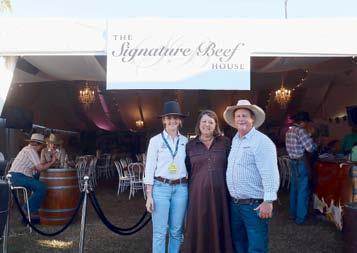
Killing 320 head per week, Blair said he and his wife take advantage of opportunities that present themselves.
“A lot of our aims is to give more opportunities to young people, there are a lot of different categories in the agricultural sector because it is so diverse,” he said.
“It’s astonishing to know that we have
been able to experience both ends of the spectrum, one being where the meat comes from and how you develop the beast to then serve it to the consumer.
“That is why we decided to do Signature Beef, to give consumers the full paddock-toplate experience.”
Being a fourth-generation cattleman,
Blair, Josie and their family of four, David, Madelaine, Lauren and John, all contributed to the restaurant.
The family took pieces of their home and life to display throughout the marquee including old photographs, horns, hats and hat racks and a video of their experience on the property through a TV.
Serving grain and long-fed beef, organiser Greta Stonier said they began planning for the event at the beginning of the year.
“As we are all ringers, none of us have experience with hospitality, so we have had to bring what we know about beef and try as best we can to provide quality customer service,” she said.
“It has been fun, but it has also been stressful at times, especially on Monday when we had an influx of customers come in.
“A few extra hands would be helpful, but we have a great understanding of the beef industry so it’s just a matter of satisfying our guests.”
Originally from Sydney, Greta began working with the Angus Pastoral Company at the beginning of 2023 as part of their graduation program.
Now working as a part of their sales and marketing team, Greta said her favourite part of the experience is seeing everything come together.
“To begin with everything was slow and steady, and now to see all of the people and how everything is set up, it looks perfect,” she said.
Day1
Day2
Day2
Tuesday 23rd July
Tummel Herefords
40 Bulls (Horned & Poll Sires) Sale @ 1pm Lochaber, Walcha NSW
Simon Hawkins 0429 389 688
Allan Laurie 0455 821 394 www.tummelherefords.com.au
Wednesday 24th July
Glenwarrah Herefords
32 Bulls (Horn & Poll) Sale @ 11.30am
David & Kate Collins, Bundarra NSW Ph: 0497 270 455
E: glenwarrahbrooksby@gmail.com www.glenwarrah.com.au
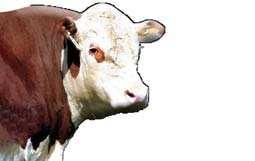
Day3
Day3


Wednesday 24th July
Glen Innes Bull Sale (Horn & Poll)
49 Bulls & 14 Females Show @ 9am & Sale @ 2pm
Catalogue Online at: www.herefordsaustralia.com.au Or from Elders – Glen Innes: 02 6739 7300
Thursday 25th July
Lotus Herefords
45 Hereford Bulls Sale @ 11.30am
Tony & Barbara Holliss, Glen Innes NSW M: 0418 655 009
E: info@lotusherefords.com.au www.lotusherefords.com.au
Thursday 25th July
Amos Vale Herefords
35 Hereford Bulls Sale @ 1:45pm
Mark & Wendy Campion, Glen Innes NSW M: 0428 334 626
E: amosvaleherefords@gmail.com www.amosvaleherefords.com.au
The


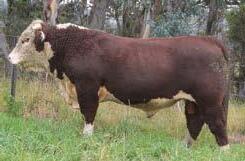
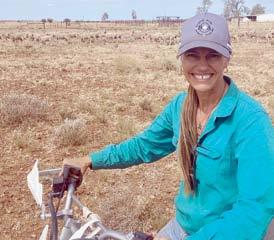

Winton wool grower and classer Jodi Axford has received the prestigious Dr Jim Watts Memorial Medal for her skill at marketing sheep, meat and wool in a challenging environment, and commitment to bettering her community.
Presented by SRS Genetics, the Medal was established in 2023 in recognition of the contribution Dr Jim Watts made to SRS (Soft Rolling Skins) sheep breeding and genetics around Australia and internationally.
SRS Genetics chairman Norm Smith said the medal acknowledged Jim’s legacy and recognised the continuation of his work with the nominees demonstrating a substantial contribution to SRS breeding and genetics, passion, drive, integrity, and ability to teach others.
“Working in a marginal environment of western Queensland, Mrs Axford has been instrumental in driving the goals and aspirations of Dr Watts and SRS Genetics in commercial flocks for over two decades,” Mr Smith said.
“Dr Watts inspired Jodi in the early 2000s to seek the SRS vision, knowledge and understanding.”
Jodi and her husband Shane Axford oper-
ate a commercial sheep breeding and trading enterprise on the 11,900ha Goolma Station at Winton.
The 2023 Dr Jim Watts Memorial Medal winner Vicki Murphy said Jodi’s passion and dedication inspired sheep producers in her area, and other Merino breeders to utilise SRS breeding principles to lift productivity.
“Jodi has a wealth of knowledge from operating the wool selling business in Winton, a shearing contracting business in central western Queensland, running the wool section at the local show and is also a qualified wool classer,” Mrs Murphy said.
“Jodi and Shane have continued to pursue his goals and breeding techniques in their commercial flock whilst showing other wool growers the way.”
Jodi regularly steps up to help within her community, acting in the past as the chief steward in the wool section at the Winton show.
The couple has hosted shearing, wool handling, and Bred Well Fed Well workshops
They were thrilled when Dr Watts began classing their flock in 2012 and considered him to be generous with his knowledge and time.
Originally from Geelong, Jodi came to love sheep while working in shearing sheds in Queensland in the 1990s and became a qualified wool classer.
“Shane and I bought a starter block and six different mobs of ewes, including a flock in transition to the SRS principles,” she said.
They were able to cease mulesing in 2009, and now join between 3000 and 4000 ewes annually with an aim to build to a “sweet spot” of 10,000 sheep.
Located in a 300mm rainfall zone, the flock grazes native pastures with the back-up of irrigated hay production for drier seasons.
“For us, SRS gave us a science backed blueprint to follow to achieve an easy-care Merino – we realised in our marginal country selection for positive fat and eye muscle was linked to survivability and retaining more lambs at weaning,” Jodi said.
“I always say judge us by our actions. If people are interested, they can come and ask, and we will happily share the knowledge.
“With young people we are always happy to encourage them into the sheep industry and pass on our skills.
“The SRS sheep are a pleasure to manage and run – we don’t have to worry about mulesing and there is rarely any flystrike, they are fertile and good mothers, are plain bodied, have a soft rolling skin and an open breach.”
The flock’s adult ewe average micron is 19.5 with a 4.8kg average fleece weight and lambs marked at 99 per cent, including the maidens, to ewes joined.
“The non-mulesed status certainly adds value and the SRS wools present well when marketing,“ Jodi said.
“I am happy with the style, crimp and comfort factor and I understand what type of skins are needed to achieve that sort of wool.
“When it comes to selection for fat and eye muscle, we know our weaner wethers will be a good weight, shape and dressing percentage for the buyer or processor.”
Every day is a new and exciting challenge for engineering technologist Jodie Kilpatrick who spends her days solving technical challenges and leading teams in geotechnics and mine waste engineering.
From water resources to tailings and dam management, Ms Kilpatrick has spent the past decade supporting the operations and management of key dam infrastructure,
She works with clients across Australia, championing inclusion and diversity within the industry.
Not one to rest on her laurels, Ms Kilpatrick has also been hard at work studying a Graduate Diploma (GEPR) and Master of Engineering Practice (MEPR) with the University of Southern Queensland (UniSQ) to keep her skills sharp.
Ms Kilpatrick said she opted for postgraduate study with UniSQ because she wanted to progress from engineering technologist to professional engineer status.
“My career is originally founded on science qualifications in hydrology and, with the direction my career has taken, I wanted the opportunity to gain the engineering qualifications to learn and apply in my projects and roles,” Ms Kilpatrick said.
“Engineering is a dynamic career pathway, which is continuing to evolve as new technologies become available.
“The Master of engineering practice gives opportunity for the whole industry to work
towards meeting the national skills shortage in the engineering field.”
The flexibility of the UniSQ MEPR program has allowed Ms Kilpatrick to study while continuing to shine in her day job, even taking out a national award in 2023.
“I aspire to be a role model for rural/remote professionals as well as women in the field of engineering, so it was a very special moment for me to win the National Emerging Technologist of the Year Award for 2023 with Engineers Australia,” she said.
School of Engineering Associate Professor Andreas Helwig said the MEPR was unique to UniSQ and would enable engineering professionals to requalify in line with upcoming state and territory legislation changes across Australia.
“Just as the undergraduate UniSQ programs are for engineering a better future, the postgraduate program curriculum is designed to develop higher degree research to innovate better engineering outcomes,” Associate Professor Helwig said.
“Innovative engineers are urgently needed for the enormous task of transforming the Queensland and Australian enterprise and economy over the next 15 years to become significantly more sustainable.
“MEPR will assist the industry by upskilling engineering technologists to professional engineers for industry employment, promoting job opportunities and accelerating existing professional career promotion.”
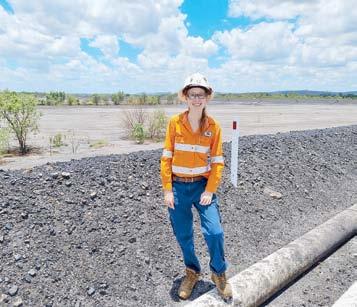
Sam Bloom, three-time world para-surfing champion, bestselling author, movie muse and nurse last month shared her inspiring journey of resilience at Beef2024 in Rockhampton.
And, what an incredible story it is.
In 2013, Sam’s dream life became a nightmare when she was 41.
While holidaying in Thailand with husband Cameron and their three young boys, she leaned against a rotten balcony railing, falling through and crashing six metres onto concrete.
The accident left her paralysed from the chest down.
Broken and completely devastated, Sam felt her life was over as the intense physical and mental hardship consumed her.
However, with courage, determination and the love of her family, she fought her way back to reclaim purpose and pride.
“By sharing my journey of healing and adapting to a life-changing injury, I hope to have encouraged the women at the Westpac High Tea that they too can find strength when they need it most,“ Sam said.
“I talked a lot about resilience and some key messages such as ‘it’s ok to not feel ok all the time. Like, just be kind to yourself’. I think it’s important to show gratitude as well.
“So, while I will never be okay with (my situation) really never ever - I hate it so much and would do anything to be me again - I am still grateful to be alive.”
Sam spent three months in hospital then battled her way through three more months of intensive rehabilitation before she was finally able to return to her home on Sydney’s Northern Beaches, only to fall into a deep and consuming depression.
The story of those dark years have been told in Sam’s book, Sam Bloom Heartache & Birdsong and in the film and book, Penguin Bloom. Then, one day she suggested to her recreation officer from “rehab“ that she could perhaps try canoeing.
And so the revival of Sam Bloom began. No longer stuck in her wheelchair, she was out on the lake surrounded by nature and free from her personal prison.
Sam eventually won two Australian titles before representing her country at the 2015 World Championships in Italy.
“Sport has helped me so much,” she said. “It’s where I get my self-belief. When I got onto the Australian kayaking team it felt like, ’okay, I actually can do something now. I can achieve cool things but just have to work harder’.
“It boosted my confidence and made me feel a little bit like my old self again.”
In 2016 - completely out of the blue - Sam received a letter from the mother of Australian professional surfer Julian Wilson.
In it, Nola Wilson gently encouraged her to reconnect with her love for the ocean and return to surfing.
“It was a super random act of kindness and so beautiful and I thought, ‘okay, I’ll give it a go’. It completely changed everything for me.”
In 2018, Sam was selected as a member of the Australian adaptive surf team and has since clinched gold for Australia at the 2018, 2020 and 2023 World Para-Surfing Championships.
And, just last month she won the Hawaiian Adaptive Surf Championships.
“Obviously winning is great, but I think the most fun thing about being a para-athlete is the amazing community,” she said.
“That, to me, is the highlight of competitions. I’ve always loved traveling so It’s beautiful seeing everyone from all over the world come together, from Costa Rica, Brazil, America, France – everywhere. It’s just the best.
“All the competitors have their own story of loss and hardships and everyone kind of gets it.
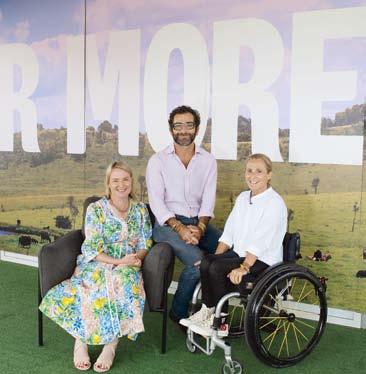
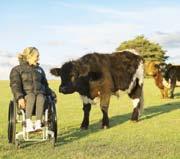



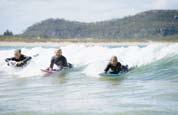



Bloom had always wanted to share her love of Africa with her three
and,
Christmas, 10 years after the accident that left her in a wheelchair, that
finally came

whether it be a sport, art or something you care about.
Ultimately, Sam has found her way forward through surfing, nature, her family and her own unexpected resilience.
“If you experience what I have, you need hope to find something that you love doing,
“Even though we all have different injuries or impairments, It’s just nice because you feel normal, you’re not the only one in the wheelchair, you’re not the only one who needs help.“
“Creating purpose will eventually lead you to happiness.
“Whenever I share my story I tell people, ’you’re never too old or too damaged to do the things that matter most. If you’re alive, your dreams are alive’.“
While it is a far different happiness to the carefree existence before her accident, for Sam now, the moments of joy are more profound, more resonant and she still has so much living to do.
* To find out more about Sam Bloom, visit her website sambloom.com.au or follow her on Instagram: @samjbloom.


Nine-year Australian stock horse ambassador, long-time entertainer and bush poet Guy McLean was at Beef2024 with four of his 34 stock horses.
Performing for the fourth time at Beef Australia from Monday 6 to Friday 10 May, the 49-year-old horseman taught attendees his tips and tricks of the trade, all with his wicked sense of humour.
Driven by passion, Guy and his wife Emily travel the world, exploring, teaching and connecting with other horsemen and agricultural enthusiasts.
“When I come to these events and I look out in the audience and see men, women and children who live on the farm, I say to myself those are the people I am trying to represent when I entertain and travel the world,” Guy said.
“It’s great to share my passion with people and I love what I do.”
Being the youngest of five boys and having an age gap compared to his siblings, Guy said he felt left out.
Growing up, Guy’s brothers were very hands-on and talented sportsmen who were useful on the farm with machinery and mechanics.
Guy was restricted in the areas his brothers thrived in as he was required to wear glasses throughout his younger years, making it difficult to play ball sports.
After feeling negatively overshadowed throughout his younger years, Guy never would have thought that his internal passion would turn out to be his incredible talent.
“I am grateful that I felt a little lost in my younger years because I soon found that when I was with my horses I didn’t feel this way,” he said.
“Horses have helped me grow and overcome many challenges I have faced in my life, and I am greatly thankful for that.”
Guy was born in Melbourne, Victoria in 1975, and raised on his parents’ 1600-acre property near Hervey Bay.
Over two years, the McLean family formed Susan River Homestead, a holiday ranch resort.
Wanting a life away from the city streets, Guy’s mother and father searched for numerous opportunities to provide for their family, hence sparking Guy’s passion for horses at just 16 months old when he was seated on one for the first time.
From there, his passion flourished into a lifelong dream.
When he was just four years old, Guy would ride his Chestnut mare, Sunny alone on rides with the guests’ of his parent’s homestead resort.
Towards the end of these rides, Guy would tend to fall asleep on the last mile home and Sunny would carry him safely back to the yards.
When he was 15 years old, Guy began working and eventually took over the trail riding

duties at the homestead, along with training and educating the general public’s horses.
Guy was in charge of and training all of the guest’s horses, totalling to 50.
On top of this, at the age of 21, Guy discovered his sentiment with poetry and would perform it while on horseback for the homestead guests.
“I would ride in on my horse with my ‘Dry as Bones’ jacket and perform for them,” he said.
“Even though I can perform in front of thousands of people, I am still very shy.
“I have wanted to be a horsemen for as long as I can remember and when the other kids all wanted to be firemen and police officers, I wanted to be a horsemen.”
Although Guy’s biggest weakness is creating a personal and mutual connection with every horse he rides, it is also one of his biggest strengths.
“I develop a special bond with all of the horses I ride,” Guy said.
“I could be a breeder but I get too attached to them.
“I had to sell four of my best horses when I was 20 and it was like a nightmare.
“The poetry people wanted to pay to see me and I thought this is a way I can keep my horses.”
Soon after Guy began performing his poetry, many guests complimented his horsemanship and asked him to do demonstrations for them, which he has done for 28 years.
“I became an entertainer because I knew I wanted to be a horseman from a young age,” he said.
“It could be three minutes until I die and I will still be riding a horse.”
Guy’s first horse and to this day, his best mate, is a then four-year-old Golden Dun Colt he called Nugget, who was bought for $200 out of a bush paddock an hour away from the homestead.
Once Guy finished his job and left the homestead, he became an entrepreneur and started his own horse training business with Nugget, Quietway Performance Horses.
The pair were then in the bridle and saddle for the next 12 years, travelling across the globe, and leading their equine team in Australia.
In 2002 and 2006, Guy was appointed as the official Ambassador of the Outback through his horsemanship, bush poetry and whip-
cracking.
Guy was awarded the inaugural winner of Equitana’s and Way of the Horse competitions in 2005.
For many years, Guy and his beloved Nugget have been recognised as a national treasure and living legends, having performed in front of over one million people.
“I am an introvert in an extrovert’s world but I love what I do,” he said.
Now at the next stage of his fantastic career, Guy continues to go global with his business Quietway Performance Horses, with Nugget being the sire of three of his international horses.
As time continues, Guy said that although he is ageing, he believes it is important for the younger generation to understand the importance of horses and how to ride them.
“They close the box on you but you never stop being a horseman,” he said.
“I think horses are incredible for teaching our kids honesty and humility and to have a hard work ethic.
“The very best-bred horses all have the same thought mentality, you can’t look into a mirror and frown and expect a smile in return, the horse is the same.”

Field day exhibitors offer plenty of choice when it comes to firefighting pumps but how do you pick one that will deliver many years of service and won’t let you down in an emergency.
John Hales, Aussie Pumps’ Chief engineer, shares some of his experience to help farmers and homeowners make informed choices when it comes to buying a fire pump.
The lightweight portable high pressure fire pump is a particularly Australian innovation.
One of the reasons Aussie Pumps sell these pumps all over the world is because of our experience tackling bushfires in our beautiful but vulnerable environment.
Today, at least one high pressure fire pump is found on most rural properties.
An essential part of a farmer’s toolbox; they serve as utility pumps used for yard and crate wash down, water transfer, even sheep jetting, as well as firefighting duties.
Even on the outskirts of our large cities, property owners are well aware of the danger of living in beautiful bushland.
This story provides some advice, for farmers and those Urban Interface dwellers, on choosing the correct fire pump!
FIGHT OR FLIGHT
The first decision to be made well ahead of any bushfire emergency is whether to stay and protect the property or plan to leave early.
If choosing the first option preparation is vital, including selecting a reliable, top quality pump that is right for the application.
It may be mounted on a fire trailer for mobile protection or installed under the house to feed a sprinkler system.
Consider purchasing more than one pump if you need to protect a large area and of course it’s always wise to have a back-up pump for emergencies.
HONDA ENGINES WORK
At Aussie Pumps, we decided to standardise on Honda engines on our pump range years ago.
We tried other brands but found that the Honda quality, performance and aftermarket support was the very best.
The major reason is simple, ‘they start first time, every time!’ In a fire emergency this is critical.
Farmers and residents know they know to rely on Honda and can be assured that they have a Honda Service Centre close by.
CHOOSING THE PUMP
When Aussie Pumps decided to design a fire pump for the Australian market we weren’t prepared to compromise on quality or performance.
The result is the Honda powered Aussie Fire Chief, now regarded as being the best lightweight portable fire pump in the world.
PERFORMANCE COUNTS
When comparing single impeller pumps, use the published performance curves.
You’ll find that the Aussie Fire Chief will outperform all others at the duty point on the curve, where it counts.
For example, our single impeller Aussie Fire Chief produces 100 litres per minute flow at 63 m head.
In the case of Davey pumps, according to performance curves, their single impeller delivers 100 lpm at around 55 metres head.
For Onga performance is much the same performance.
So, with the same Honda engine, a model GX160 5.5hp, the Aussie Fire Chief outperforms its competitors.
The Aussie Fire Chief comes standard with a big 2” flanged suction port.
That port can also be changed out to a 3” version when more flow is required.
Its flanged design makes it easy to remove to give access to the check valve, without having to take the whole body apart.
Best of all, the 2” suction port, compared to a pump with 1½” inlet, means you get 25% more water into the pump! More water in means more water out.

We also value add features that improve functionality like metal caps and chains on the three-way outlet, not plastic, a carry handle and skids that add stability.
THE INSIDE STORY
Apart from checking performance and the exterior of the pump, it’s nice to get a look inside.
When you open up an Aussie Fire Chief, you find a big 7” impeller, beautifully engineered and balanced to provide the best possible performance.
Most importantly, it doesn’t overload the engine at any point on the curve!
The engine has been perfectly matched to the impeller diameter and approved by Honda for this application.
BEWARE OF GIMMICKS
Some brands offer additional ports on the outlet and customers may believe that they can operate hoses on all these simultaneously.
It’s the pump design and inlet port size that determines its capability.
The more hoses added onto the outlet, the less water each will deliver.
With its 2” inlet, the Aussie Fire Chief can be used effectively with either two 1” hoses simultaneously, to maximise the area covered, or a single 1½” hose if more flow is important.
FIVE YEAR WARRANTY
When we introduced a five year warranty on our Aussie Fire Chief 20 years ago, everybody said it would send us bankrupt.
Here we are 20 years later and we constantly receive feedback from users telling us that they think our product is the best they have ever had.
The Aussie Fire Chief is the only fire pump with a five year warranty.
A WORD OF ADVICE
Make sure you get the best advice as to what is required for your application and most of all, don’t compromise when it comes to protecting your property, livestock or family.
Price is not a reliable indication of quality, but if the pump is too cheap you have to ask yourself why?
We often hear from users who have bought
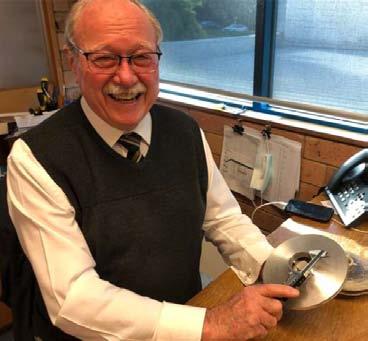
third world pumps that have failed prematurely.
This is not an application where it makes sense to save a few hundred bucks.
Aussie Pumps has a band of loyal Gold Distributors throughout the state that are primed to assist.
They not only stock and sell Aussie fire pumps, but have experience in pump selection, and can support the product through its life with spares and service.
AUSSIE’S BUSHFIRE SURVIVAL GUIDE
For further assistance on selecting and setting up your pump, Aussie produce free of charge a Bushfire Survival Guide.
It’s available from all Aussie Gold Distributors or it can be downloaded from the Aussie Pump website.
Talk to your local Aussie Pump dealer or call the Aussie Pump team. Find your local dealer online at aussiepumps.com.au.
Primary producers in southern Queensland are being urged to take a proactive approach in managing their farm finances, with interest rates peaking and the cost of inputs surging by as much as 67 per cent.
Rural Financial Counselling Service Southern Queensland chief executive officer Ross Leggett said interest rates on finance were 2.4 times higher than two years ago, adding an extra $3000 a month to the repayments on every $1 million borrowed.
That’s a $36,000 a year hit to farm profitability.
“The situation we’re dealing with is essentially a cost squeeze, as revenues are not increasing at the same rate as direct input costs such as fuel and fertiliser,” Mr Leggett said.
“This has a direct impact on farm profitability and requires an increased focus on business planning by producers to successfully manage their business in this environment.”
Compared with four years ago, fertiliser costs for southern Queensland’s crop producers are up to 67 per cent higher, meaning that for every 1000 acres of land cropped approximately $10,500 extra needs to be spent on fertiliser.
The on-farm price of diesel has also spiked nearly 60pc in three years according to data from the Australian Institute of Petroleum, rising from $1.20 a litre in April 2021 to $1.88 in April 2024.
The outlook from the Australian Bureau of Agricultural and Resource Economics and Sciences (ABARES) is unsettling, with farm input prices expected to remain high in 2024 while prices received for agricultural production are forecast to fall by seven per cent.
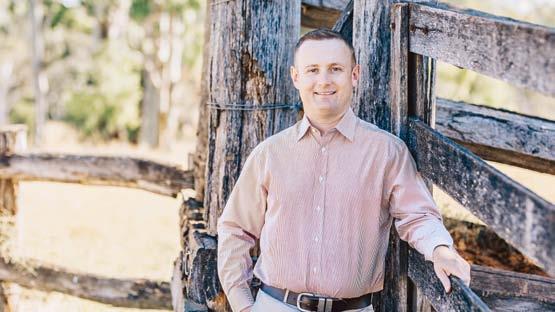
Mr Leggett said producers could explore their options with free, local and confidential support from the Rural Financial Counselling Service, which is seeing an increase in contact from producers keen to stay in control of their farm business.
“Interest rates cut across every farm business and finance is typically the single largest input cost,” he said.
“But we’re conscious that there’s a substantial cohort of producers who may be ignoring the warning signs and we’re keen to engage with them. Early intervention is critical as it gives people more options.”
Mr Leggett acknowledged many farmers
preferred to focus on the physical aspects of their business rather than the financials, but engaging locally-based financial counsellors could help.
“One of the characteristics of financial hardship is that people self-diagnose themselves as the only ones in a challenging situation, so they pull back from accessing the networks available,” he said.
“I want to say that you’re not alone and we can help.
“The Rural Financial Counselling Service is a service designed to provide support within your region and we can assist with business planning and budgets so you’re tackling issues early and with excellent support.”
For more information go to the RFCS website www.rfcssq.org.au/options or call the confidential telephone service on 07 4622 5500.
There are few who don’t recognise the names Dorothea Mackellar, Banjo Paterson, Henry Lawson, Oodgeroo Noonuccal and Rupert McCall and their spine-tingling odes to Australia’s ‘sweeping plains, ragged mountain ranges, droughts and flooding rains’.
It’s fitting therefore, that one of the nation’s richest poetry competitions is staged in one of the nation’s most beautiful Outback towns – Cloncurry.
Inspired by iconic Cloncurry local Dame Mary Gilmore, the Cloncurry Prize poetry competition is calling on amateur, inspiring and renowned poets alike to put ink to paper for their chance to win the $10,000 cash prize.
The annual poetry competition attracted more than 160 entries in 2023 and was won by New South Wales poet Penny Lane with Remembering Mary, a beautifully painted picture of an outback hero worthy of much praise.
All styles of poetry are accepted and this year’s theme is ‘Standing on the Shoulders of Giants’, through the lens of Outback Australia.
Also, there is a junior Cloncurry Prize, open to all Queensland school-aged students, with a cash prize of $250.
“This year’s theme could see poems about a 30-metre-long Sauropod or an unrideable horse or even a child remembering their father,“ said Cloncurry Mayor Greg Campbell.
“The Outback provides limitless inspiration and it’s exciting to call both adult and junior poets, amateur and published to enter.
“The competition shines the light on the Outback, promoting its natural beauty, larger-than-life characters and their stories and the theme this year will generate some fantastic reads.
“The prize was created to remind people of the wonderful country we live in and to ignite a sense of national pride.
“Dame Mary Gilmore had a very strong connection to Cloncurry and was a true

hero of the Outback, a pioneer in education and literacy; her powerful writing continues to inspire.
“This
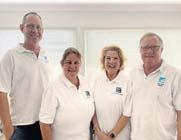

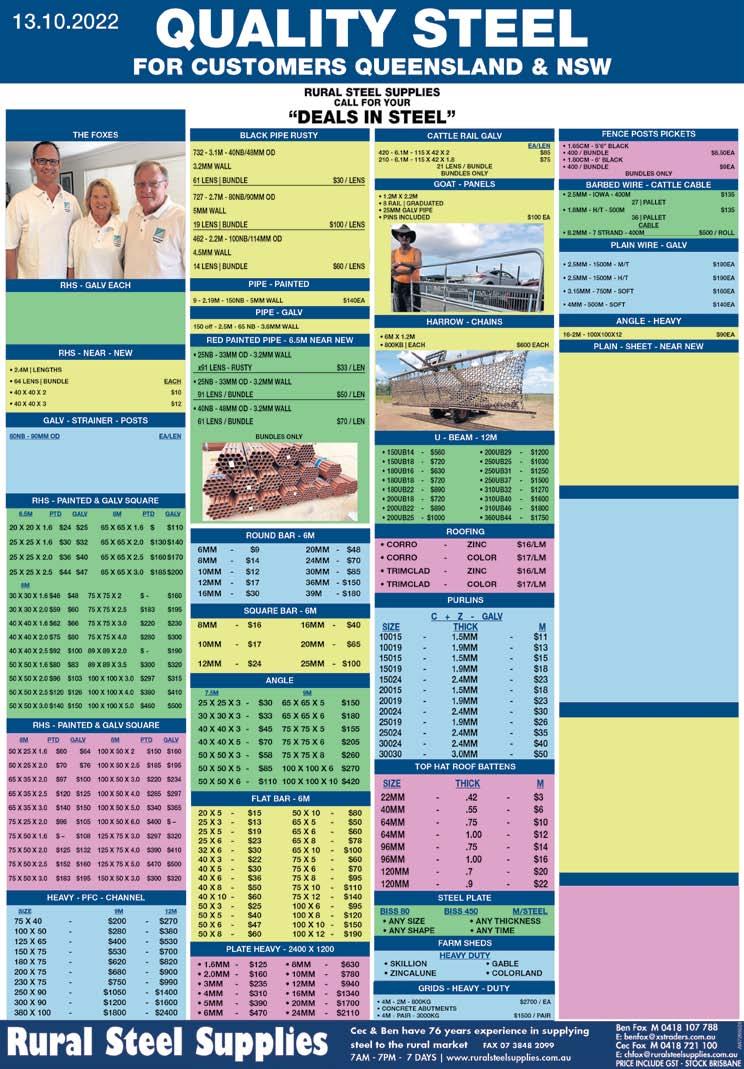



Beef2024 has been a world-class exhibition of all things beef, with the industry coming together all in one place, at the one time, to promote, advance and celebrate our nation’s sustainable beef industry.
It is the largest event of its type in the Southern Hemisphere and, this year it was truly a globally recognised livestock show with the return of the International Program, and Beef TV streaming live across the world.
During 5-11 May, Beef2024 hit some records and saw:
· 119,324 movements through the gates
· Over 600 international delegates attend from across 35 countries
· Over 3,800 school children participate in the Suncorp Bank School’s Program, with an additional 1,200 students visiting outside of the program.
· 79,000 people tuned in live across the world on Beef TV
· More than 12,500 ticketed meals enjoyed
· Over 1,300 head of cattle judged in Centre Ring, from across 28 breeds
· Over 1,600 head of cattle sold for over $3.9million in the 2024 Nutrien Ag Solutions Commercial Cattle Championship Sale of Champions
· Over 40 Australian political leaders, including the Prime Minister of Australia and the Premier of Queensland descended on Beef2024
· 10 Celebrity Chefs showcase their expertise in the kitchen cooking up meals to audiences
· 35.5tonne of beef served onsite during the week.
Champion Results
NUTRION AG SOLUTIONS (NAS) YOUNG COMMERCIAL JUDGES TOP HONOURS
· Georgia Lynch
NAS COMMERCIAL CATTLE CHAMPIONSHIP WINNERS
· Mylrea family
NAS JUNIOR STUD CATTLE CHAMPIONSHIP COMPETITIONS
NAS COMMERCIAL CATTLE CHAMPIONSHIP
· Essex Grazing Co, Middlemount DATAMARS LIVESTOCK YOUNG JUDGES COMPETITION
· Alexandra Olive
JUNIOR PARADERS COMPETITION
· George Streeter, Fairy Springs Brahman Stud, Theodore CHARBRAY SOCIETY JUNIOR SCHOOL TEAM COMPETITION
· Downlands College
DATAMARS LIVESTOCK JUNIOR LED STEER CHAMPION
· A 544kg Square Meater x Limousin, Thumper, led by Lily Moore, Ilford, New SouthWales. NAS STUD CATTLE INTERBREED CHAMPIONSHIP, SUPREME CHAMPION BULL
· Oakwood Cutirgh, Limousin Stud cattle championship results: BREED
· Brahman JUDGE
· Matthew McCamley
CALF CHAMPION MALE
· Radella Bicardi
RESERVE CALF CHAMPION MALE
· Whitaker Mr Sinner
CALF CHAMPION FEMALE
· Mianna Miss Appollo 107/3
RESERVE CALF CHAMPION FEMALE
· Cambil Jewel 7071
JUNIOR CHAMPION MALE
· Viva Augustus 2613
RESERVE JUNIOR CHAMPION MALE
· Whitaker Mr Navy
JUNIOR CHAMPION FEMALE
· Token Miss Praise
RESERVE JUNIOR CHAMPION FEMALE
· Cambil Holly 6869
SENIOR CHAMPION MALE
· Viva Maxibon
RESERVE SENIOR CHAMPION MALE
· Raglan Mr Nathan
SENIOR CHAMPION FEMALE
· Raglan Miss Noella
RESERVE SENIOR CHAMPION FEMALE
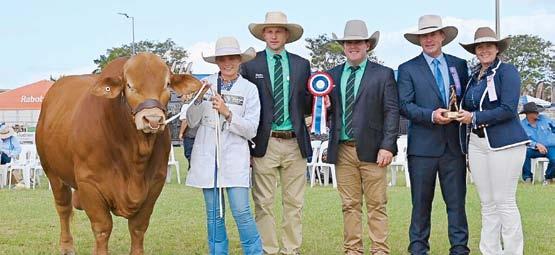
· Timbrel Miss Polled Kyren Manso
GRAND CHAMPION BULL
· Viva Maxibon
GRAND CHAMPION FEMALE
· Raglan Miss Noella
EXHIBITORS GROUP
· Raglan Brahmans
SIRE PROGENY STAKES
· Cambil Brahmans
DAM PROGENCY STAKES
· Cambil Brahmans
BREED
· Brangus
JUDGE
· PJ Budler
CALF CHAMPION MALE
· Bullakeana Xtra Boombastic
RESERVE CALF CHAMPION MALE
· Bullakeana XXL
CALF CHAMPION FEMALE
· Bullakeana Xtra Perfect
RESERVE CALF CHAMPION FEMALE
· Beejay Tessa
JUNIOR CHAMPION MALE
· Bullakeana Who’s Handsome
RESEVER JUNIOR CHAMPION MALE
· Lazy S Havelock
JUNIOR CHAMPION FEMALE
· Rockyview Savannah
RESERVE JUNIOR CHAMPION FEMALE
· Black Label Miss Bouquet 051
SENIOR CHAMPION MALE
· Ramsey Creek Magic M85
RESERVE SENIOR CHAMPION MALE
· Weona Lawson
SENIOR CHAMPION FEMALE
· Viamonte Red Bluebelle Q011
RESERVE SENIOR CHAMPION FEMALE
· Kraken Nutella 040S
GRAND CHAMPION MALE
· Bullakeana Who’s Handsome
GRAND CHAMPION FEMALE
· Viamonte Red Bluebelle Q011
EXHIBITORS GROUP
· Hanson Cattle Co
SIRE PROGENY STAKES
· Hanson Cattle Co
DAM PROGENCY STAKES
· Hanson Cattle Co
BREED
· Angus
JUDGE
· Graeme Hopf
CALF CHAMPION MALE
· K5X Unique U5
RESERVE CALF CHAMPION MALE
· Diamond PC 338 The Undertaker U404
CALF CHAMPION FEMALE
· PC Diamond Miss Quick Silver U035
RESERVE CALF CHAMPION FEMALE
· PC Diamond Miss Royal Roll U030
JUNIOR CHAMPION MALE
· K5X Think Big T67
RESERVE JUNIOR CHAMPION MALE
· K5X Turbo T60
JUNIOR CHAMPION FEMALE
· PC Diamond Miss Royal Roll T347
RESERVE JUNIOR CHAMPION FEMALE
· Spring Hill Abigail U121
SENIOR CHAMPION MALE
· Bowenfels Reality T1
RESERVE SENIOR CHAMPION MALE
· PC Diamond Top Prize T048
SENIOR CHAMPION FEMALE
· PC Diamond Miss Unanimous S032
RESERVE SENIOR CHAMPION FEMALE
· PC Diamond Miss Royal Roll T320
GRAND CHAMPION FEMALE
· PC Diamond Miss Unanimous S032
GRAND CHAMPION MALE
· Bowenfels Reality T1
EXHIBITORS GROUP
· Pine Creek Angus Stud
SIRE PROGENY STAKES
· Pine Creek Angus Stud
DAM PROGENY STAKES
· Pine Creek Angus Stud
BREED
· Speckle Park
JUDGE
· Peter Falls, Finley NSW CALF CHAMPION MALE
· Jackungah Undervalued U129
RESERVE CALF CHAMPION MALE
· Sowden Sgt Pepper 2D
CALF CHAMPION FEMALE
· Jackungah HS 109F Kassy U123
RESERVE CALF CHAMPION FEMALE
· Ivery Downs Upgrade U24
JUNIOR CHAMPION MALE
· Superb Top Shot
RESERVE JUNIOR CHAMPION MALE
· Black Diamond 827F Tropical Rum T2153
JUNIOR CHAMPION FEMALE
· Celamba Jewel of Justice
RESERVE JUNIOR CHAMPION FEMALE
· Celamba Royal of Justice
SENIOR CHAMPION MALE
· Sowden Bite the Bullet
RESERVE SENIOR CHAMPION MALE
· Black Diamond Test Ride T1668
SENIOR CHAMPION FEMALE
· Black Diamond N86 Silky Touch S1606
RESERVE SENIOR CHAMPION FEMALE
· Jackungah HS J301 Bambe S27
GRAND CHAMPION MALE
· Sowden Bite the Bullet
GRAND CHAMPION FEMALE
· Black Diamond N86 Silky Touch S1606
EXHIBITORS GROUP
· Black Diamond Speckle Park Stud
SIRE PROGENY STAKES
· Superb Speckle Park Stud
DAM PROGENY STAKES
· Superb Speckle Park Stud
BREED
· Charolais
JUDGE
· Peter Collins
NUMBER OF EXHIBITS
· 111 CALF CHAMPION MALE
· Cassaglen Under Rated
RESERVE CALF CHAMPION MALE
· Milford Maximus
CALF CHAMPION FEMALE
· 4 Ways MK Koko U30E
RESERVE CALF CHAMPION FEMALE
· Milford Aletta
JUNIOR CHAMPION MALE
· Brendale Tab
RESERVE JUNIOR CHAMPION MALE
· 4 Ways MP T58E
JUNIOR CHAMPION FEMALE
· Cassaglen Lady in Red
RESERVE JUNIOR CHAMPION FEMALE
· Winkel Park Penny
SENIOR CHAMPION MALE
· Moongool Tanner
RESERVE SENIOR CHAMPION MALE
· Moongool Tab
SENIOR CHAMPION FEMALE
· Clearview Raine
RESERVE SENIOR CHAMPION FEMALE
· 4 Ways MLR Frankie S45E
GRAND CHAMPION MALE
· Moongool Tanner
GRAND CHAMPION FEMALE
· Clearview Raine
EXHIBITORS GROUP
· 4 Ways Charbrays
SIRE PROGENY STAKES
· 4 Ways Charolais
DAM PROGENY STAKES
· Clearview Charolais
BREED
· Fleckvieh
JUDGE
· Grame Hopf
CALF CHAMPION MALE
· Trinity Male Urban Sensation
RESERVE CALF CHAMPION MALE
· Wondenia-Denmire Utah
CALF CHAMPION FEMALE
· Trinity Vale Undercover Angel
RESERVE CALF CHAMPION FEMALE
· Wondenia-Denmire Unique
JUNIOR CHAMPION MALE
· Tennysonvale Theo
RESERVE JUNIOR CHAMPION MALE
· Trinity Vale Ureka
JUNIOR CHAMPION FEMALE
· Wondenia-Denmire Treasure
RESERVE JUNIOR CHAMPION FEMALE
· Three Moon Emerald
SENIOR CHAMPION MALE
· Stone Ridge Talladega
RESERVE SENIOR CHAMPION MALE
· Wondenia Truman
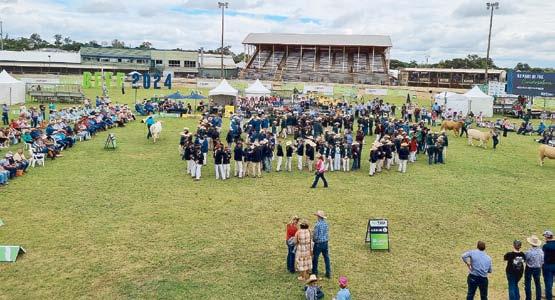
SENIOR CHAMPION FEMALE
· Wondenia Toffee
RESERVE SENIOR CHAMPION FEMALE
· Rocky Tolliseen
GRAND CHAMPION MALE
· Tennysonvale Theo GRAND CHAMPION FEMALE
· Wondenia-Denmire Treasure
EXHIBITORS GROUP
· Country Sand and Concrete Pty Ltd Wondenia-Denmire Fleckvieh Stud
SIRE PROGENY STAKES
· Country Sand and Concrete Pty Ltd Wondenia-Denmire Fleckvieh Stud
DAM PROGENY STAKES
· Country Sand and Concrete Pty Ltd Wonde-

nia-Denmire Fleckvieh Stud
BREED
· Ultrablack
JUDGE
· PJ Budler
CALF CHAMPION MALE
· Palgrove Untouchable U98
CALF CHAMPION FEMALE
· Palgrove Star U113
RESERVE CALF CHAMPION FEMALE
· Palgrove Bara U261
JUNIOR CHAMPION MALE
· Bullakeana Wide Load
RESERVE JUNIOR CHAMPION MALE
· Palgrove Thurston T1169
JUNIOR CHAMPION FEMALE
· K5X Miss Foundation T40
SENIOR CHAMPION MALE
· Palgrove Truman T971
SENIOR CHAMPION FEMALE
· Bullakeana Very Now
RESERVE SENIOR CHAMPION FEMALE
· Palgrove IA Mila S129
GRAND CHAMPION BULL
· Bullakeana Wide Load
GRAND CHAMPION FEMALE
· Bullakeana Very Now
EXHIBITORS GROUP
· Hanson Cattle Co
SIRE PROGENY STAKES
· Hanson Cattle Co
DAM PROGENY STAKES





· Hanson Cattle Co
BREED
· Charbray
JUDGE
· David Bondfield
CALF CHAMPION MALE
· Rosewood UE
RESERVE CALF CHAMPION MALE
· Huntington Upton
CALF CHAMPION FEMALE
· Huntington MME Henri U295
RESERVE CALF CHAMPION FEMALE
· Huntington Meggie U293
JUNIOR CHAMPION MALE
· Wattlebray TNT
RESERVE JUNIOR CHAMPION MALE
· Huntington Tungston
JUNIOR CHAMPION FEMALE
· Wattlebray Trinity
RESERVE JUNIOR CHAMPION FEMALE
· Diamond L Urshula
SENIOR CHAMPION MALE
· Greenfields Smithy
RESERVE SENIOR CHAMPION MALE
· Huntington Thunder
SENIOR CHAMPION FEMALE
· Wattlebray Rayna 82/1
RESERVE SENIOR CHAMPION FEMALE
· Wattlebray Tiara
GRAND CHAMPION MALE
· Greenfields Smithy
GRAND CHAMPION FEMALE
· Wattlebray Rayna 82/1
EXHIBITORS GROUP
· Wattlebray Charbrays
SIRE PROGENY STAKES
· Wattlebray Charbrays
DAM PROGENY STAKES
· Rangeview Charbrays
To find out more stud cattle championship results head to the Queensland Farmer Today website.
Beef Australia’s week-long exhibition will be back in 2027 from 2 - 8 May.













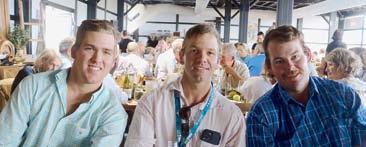
When mum-of-four Vanessa Challacombe started a passion project, little did she know it would grow to become a juggernaut.
Vanessa parlayed her knowledge of the agricultural indsutry and love for kids to develop Little Spurs and Co.
Established in 2021, the business is an Australian-owned award-winning country-wear label that provides dress shirts, polos, fishing shirts, caps and sunglasses to children, teenagers and adults.
Vanessa first thought of being an entrepreneur after she had her twin daughters, Saxby andVienna.
“I wanted to get back into the workforce, but I didn’t want to be micro-managed or back working for other people,”Vanessa said.
“My partner and I wanted to have the freedom of taking holidays when we want and taking the business on the road with us.”
Based on their property in Capella, the rural clothing business is an online shopping retailer that does pop-up shops
across Central Queensland.
Recently, the group has expanded from being a national brand to now an international one.
“It is very exciting,”Vanessa said.
In preparation for Beef2024, the business had an enormous clothing release exclusive to the event.
“This took me six months of planning and designing,”Vanessa said.
“We had a massive photoshoot that was released mid-August 2023.
“The feedback I have received has been amazing and I am very proud of my business.”
This being her first time at Beef2024,Vanessa said many wholesalers have approached her.
“I love Beef Australia, it’s definitely my type of crowd,” she said.
“While at Beef2024 I have been contacted by many wholesalers who want to do business with me.
“I am excited to see where this leads me and Little Spurs and Co.”

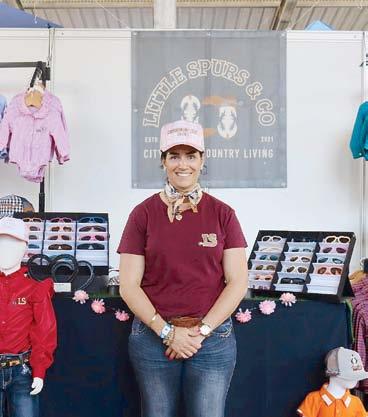

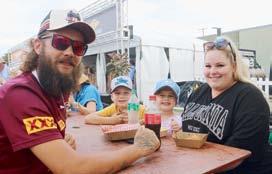

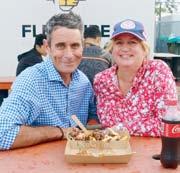
Today Journalist Sophie Mossman was out and about on M’eat Street at Beef2024 snapping some photos of people as they enjoyed a meal from one or several food vendors. Did she spot you on M’eat Street?



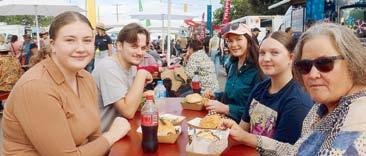
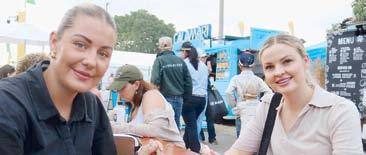


Report Date: 22/05/2024
Saleyard: Casino
Numbers were down slightly for a yarding of 1,500 head. There was a large number of young cattle and a good penning of cows.The yarding of young cattle consisted mainly of vealers and weaner cattle, with limited numbers of yearlings this week.
Quality was very mixed with a large percentage of weaner cattle showing the affects of the continuing wet conditions, with some producers having no other option but to sell cattle.
The market varied considerable with not all buyers operating and quality having a bearing on prices. There was however several lines of well bred weaner steers and heifers through the sale.
Restocker weaner steers were 5c to 10c cheaper for the medium weights, however the lights steers were 30c to 40c cheaper, most steers sold from 268c to 386c, to average 340c, while light restocker steers were down as much as 30c to 40c depending on condition and quality selling from 240c to 380c for a average of 311c/kg. Light restocker weaner heifers were 30c to 40c cheaper, while the heavier heifers were less affected recording sales of 148c to 292c/kg.
A outstanding pen of heavy vealers were purchased by a local butcher for 338c/kg.
There was only a few pens of grown steers that sold firm toping at 278c and grown heifers reached a top price of 258c/kg. the cow market was 10c to 15c cheaper with 2 score medium weight selling from 170c to 193c and 3 score medium weights averaged 201c, while 4 score cows ranged from 193 to 231c/kg. Report compiled by Doug Robson Report Date: 16/05/2024
Saleyard: Blackall
Blackall Agents yarded 2,074 head. All the regular processors feedlotters and backgrounders present and active.
A mixed quality yarding of steers and heifers penned with a good run of prime condition cows and bullocks.
Light yearling steers under 200kg topped 344c to average 294c/kg. Yearling steers 200 to 280kg averaged 303c and made to 360c/kg. Yearling steers 280 to 330kg sold to 350c with the majority selling from 160c to 278c/kg.Yearling steers 330 to 400kg sold from 230c to 332c/ kg. Yearling steers 400 to 480kg topped 296c/ kg.
Light weight yearling heifers under 200kg made to 306c/kg. Yearling heifers 200 to 280kg sold from 218c to 302c/kg. Yearling heifers 280 to 330kg made to 300c/kg. Yearling heifers 330 to 400kg sold from 160c to 302c/kg. Yearling heifers over 540kg made to 270c/kg. Grown steers 500 to 600kg made to 272c with the over 600kg sold to 274c/kg. Grown heifers over 540kg sold well to 270c/kg.
A quality yarding of prime conditioned
cows penned. The 2 score cows 400 to 520kg sold from 140c to 216c/kg. The 3 score cows over 520kg made to 232c/kg. The best of the heavy weight bulls sold to 240c/kg.
Market Reporter, David Friend
Report Date: 22/05/2024
Saleyard: Dalby
The number of cattle penned at Dalby reduced by 1,092 head to 4,088.
Export buyer attendance was good and included southern operators as well. The regular feed and trade buyers plus restockers were active. Young cattle experienced mixed results depending on weight and quality.
Light weight yearling steers returning to the paddock could not maintain the levels of the previous sale however feeder classes received a small improvement in price. Demand for yearling heifers also varied with light weights cheaper, and a lift in the overall standard of the under 330kg lines resulted in a dearer trend. Medium weight plain condition cows to restockers sold to a firm market however cows to processors averaged 8c to 10c and up 15c/ kg less.
Light weight yearling steers returning to the paddock averaged 366c and made to 416c with the under 330kg classes making to 412c to average 377c/kg. Yearling steers to feed for the domestic market averaged from 352c to 376c the occasional sale to 410c/kg. Heavy weight yearling steers to feed made to 350c to average 330c/kg.
Light weight yearling heifers returning to the paddock averaged 271c and made to 310c and the under 330kg lines made to 324c to average 304c/kg. Medium weights to feed made to 336c to average 300c and heavy weights averaged 282c with sales 310c/kg.
A handfull of bullocks made to 310c/kg. Medium weight 2 score cows to restockers averaged 202c and made to 214c/kg. Medium weight 2 scores to processors averaged 193c/ kg. Heavy weight 3 scores made to 232c and averaged 224c/kg.The best of the heavy weight cows made to 236c/kg. Heavy weight bulls made to 271c/kg. PTIC cows sold open auction made to $1,250/head with most close to $1,200/head.
Market Reporter, Trevor Hess
Report Date: 16/05/2024
Saleyard: Emerald
Numbers decreased by 910 head at Emerald sale with a yarding of 1908 head offered. Quality and condition were very good through most of the offering which was drawn from mostly local and near local districts.
There were quality related variations through much of the yard with a general improvement in cow prices.
Light weight yearling steers sold to 387c/ kg, recording averages from 313c to 319c/kg for the better-bred pens. Medium weight lines
sold to 393c/kg, averaging 309c to 352c/kg for the best. Light weight yearling heifers made to 247c/kg - averaging 221c to 246c/kg. Medium weights reached 250c/kg with a larger draft averaging 249c/kg.
Grown steers and bullocks to processor interests reached 286c/kg with averages reported from 256c to 272c/kg. Feeder steer lines made from 250c to 315c/kg. Grown heifer pens mostly went to the trade buyers to average 233c to 260c/kg.
Prime, heavy, four score cows sold to 247c/ kg returning improved averages of 234c/kg. Heavy bulls to processors averaged 226c/kg with those to livex averaging 216c/kg.
Reporter: Richard Thomson Report Date: 22/05/2024
Saleyard: Roma
With the anticipation of larger numbers Roma Agents penned 8,712 head 3,828 head more than the previous sale. Cattle were drawn from NT SA NSW and QLD. The yarding consisted of bullocks heavy feeders and large consignments of quality weaners and prime condition cows. The market was firm to dearer for yearling steers however heifers and cows could not maintain the levels from the previous sale.
Light weight yearling steers under 200kg topped at 440c to average 421c/kg. Yearling steers 200 to 280kg sold from 310c to 448c/kg. Yearling steers 280 to 330kg averaged 378c topping at 413c/kg. Yearling steers 330 to 400kg averaged 355c and sold from 306c to 392c/kg. Yearling steers 400 to 480kg sold well to 358c to average 338c/kg. Yearling steers over 480kg sold from 268c to 350c/kg.
Light weight yearling heifers under 200kg sold from 184c to 300c/kg. Yearling heifers 200 to 280kg topped at 320c with the 280 to 330kg selling to 310c/kg.Yearling heifers 330 to 400kg the majority selling to 302c to average 289c/ kg. Yearling heifers 400 to 480kg also made to 302c/kg. Yearling heifers over 480kg sold from 218c topping at 288c/kg.
Grown steers 400 to 500kg made to 270c/kg. Grown steers 500 to 600kg sold from 220c to 314c/kg. Bullocks over 600kg topped 299c/kg. Grown heifers over 540kg made ton 272c/kg. Another line up of quality prime conditioned cows however could maintain the prices of the previous sale. The 2 score cows 400 to 520kg sold from 140c to 225c/kg. The 3 score cows with the majority selling from 198c to 240c/ kg. The best of the heavy weight bulls sold to 276c/kg.
Market Reporter, David Friend
Report Date: 20/05/2024
Saleyard: Toowoomba
The number of stock penned at Toowoomba reduced to 134 head following the large number the previous week.Young cattle were in the largest numbers along with a small selection of bullocks and cows. Buyer attendance was similar to the previous week as well as a large

number of onlookers. Yearling steers to feed experienced a small improvement in price and the remainder sold to firm demand for the quality penned.
Light weight yearling steers under 200kg to restockers made to the occasional 460c to average 383c/kg. Yearling steers to feed for the domestic market averaged from 348c to 355c with sales to 368c/kg. Heavy weight yearling steers to feed made to 330c/kg. Light weight yearling heifers under 200kg returning to the paddock made to 290c to average 256c/kg. Light weight yearling heifers to processors averaged 218c and made to 230c/kg. Yearling heifers to feed made to 282c to average 262c and the occasional heavy weight made to 270c/kg.
A couple of bullocks to the local meat trade made to 280c/kg and returned $1,703/head. Plain condition cows made to 170c and the best of the heavy weights penned made to 210c/kg. Light weight bulls sold open auction made to $470/head.
Report Date: 21/05/2024
Saleyard: Warwick
The supply of stock at Warwick remained unchanged with 1,186 cattle penned. All the usual processors and feeder buyers attended along with local restockers.
The yarding was mixed with the better quality and finished lines improving in price however the plainer quality yearlings still only received limited competition.
Light weight yearling steer to background made 328c to average 288c/kg. Yearling steers over 200kg to restockers made 404c to average 339c up by 10c/kg.Yearling steers over 280kg to background made 354c/kg. Yearling steers to feed for the domestic market made 340c with restockers paying to 361c and averaging 317c/ kg. Heavy yearling steers to feed averaged 308c and sold to 320c with those to the wholesale meat trade at 370c/kg. Yearling heifers in the 200-280kg range to background made 280c to average 254c/kg.
Euro cross yearling heifers over 280kg to feed topped at 328c/kg.Yearling heifers to feed for the domestic market made 330c to average 287c/kg. Heavy yearling heifers to feed made 271c to average 260c/kg.
Grown steers over 400kg to feed sold to 310c and averaged 292c/kg. Bullocks to processors improved in price averaging 291c and selling to 304c/kg. Grown heifers to processors made 283c to average from 271c to 274c/kg. Light weight plain cows to processors sold from 168c to 215c up by 6c/kg. Heavy score 2 cows sold from 200c to 219c up by 4c/kg with the score 3 and 4 cows selling from 210c to 240c/kg. Heavy bulls to processors made 270c to average 259c/ kg.
Prep time: 5 mins
Cook time: 10 mins
Serves: 1
Difficulty: Easy
Ingredients:
· 1 tbsp olive oil
· 4 mushrooms, sliced
Method:
1. Heat oil in a small (approx. 20-24cm) non-stick frying pan over medium high heat. Add mushrooms and cook 2-3 minutes. Add tomatoes and continue cooking until just softened. Season with salt and pepper and transfer to a bowl. Reduce heat to medium.
2. Whisk eggs and milk together and season with salt and pepper
3. Sprinkle cheese evenly over the base of the frying pan. Once cheese is melted and bubbling, pour egg mixture over the cheese.
4. Without stirring or tilting pan. Cook for about 3-4 minutes until set around the
· 5 cherry tomatoes, halved
· Salt and pepper
· 2 eggs
· 1 tbsp milk or cream
· 1/3 cup grated tasty cheese
· Basil leaves
· Mixed leaves and cherry tomato salad, to serve
edges. Loosen set edges with a heatproof rubber spatula. Cook for a few minutes more until almost set on top, use spatula to loosen from the bottom.
5. Spoon mushroom and tomato mixture over one side of omelette. Fold omelette over mushrooms and tomatoes. Transfer to a plate. Scatter with basil leaves. Serve immediately with tomato salad.
Tips:
· You must use a non-stick frying pan for the perfect golden crust so it will slide out easily.
· Keep an eye on the heat and reduce if cheese is browning too quickly before egg is setting.
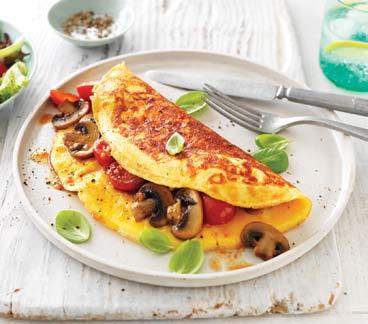
Prep time: 1 hour
Cook time: 1 hour
Serves: 10
Difficulty: Medium/Expert
Ingredients: Lemon Curd
· 4 egg yolks
· 1 egg
· 1 1/2 tablespoons cornflour
· 1/2 cup (110g) caster sugar
· 2 teaspoons lemon zest
· 2/3 cup lemon juice (approx. 2 lemons)
Method:
To make lemon curd
1. Combine egg yolks, egg, cornflour, sugar, zest and lemon juice in a large heatproof microwave-safe bowl. Whisk until combined. Add butter and place onto microwave turntable.
2. Follow manufacturer’s instructions to reduce microwave power to 50%. Cook uncovered for 7-10 minutes, stirring every minute until mixture is thick enough to coat the back of a wooden spoon.
3. Cover curd surface with plastic wrap to prevent a skin forming. Cool to room temperature. Refrigerate overnight. Sponges
1. Preheat oven to 180C/160C fan forced. Grease three 20cm round cake pans. Line bases and sides with baking paper, extending paper 3cm above pan edges.
2. Place eggs in a large bowl of an electric mixer. Using whisk attachment, beat for 5-6 minutes on high speed or until thick and pale. Add sugar, 1 tbsp at a time, beating between each addition. Beat in vanilla.
3. Sift flours twice onto a sheet of baking paper then sift again over egg mixture. Add 1 tbsp of boiling. Gently fold to combine. Do not stir or beat. Divide evenly among prepared pans.
4. Bake for 20-22 minutes, or until golden brown and sponge slightly shrinks away from pan sides. Cool in pan for 15 minutes. Turn out onto a wire rack covered with baking paper. Allow to cool.

· 125g chilled butter, diced Sponge
· 6 eggs, at room temperature
· 1 cup caster sugar
· 2 teaspoons vanilla extract
· 1 cup self-raising flour
· 1/2 cup plain flour
Icing and Filling
· 2 cups icing sugar mixture
· 1/2 cup milk
· 300ml thickened cream
· 200ml crème fraiche
Icing
1. Sift icing sugar into a large wide bowl. Add milk and whisk until smooth. Spread coconut onto a flat tray. Roll sides of two sponges in icing then roll in coconut until well coated. Use a spoon to spread some of the icing around top edge of sponges and sprinkle with coconut.
Set aside to set.
2. Repeat to coat the sides of remaining sponge. Spread the base of the sponge lightly with icing and sprinkle liberally with coconut. Set this sponge aside for the top.
To assemble
1. Whip thickened cream until soft peaks form. Add crème fraiche and beat until firm peaks hold. Place one sponge on a cake stand with coconut edge facing up. Spread with half of the cream.Whisk lemon curd until smooth. Spoon over 1/3 cup.
2. Repeat with another layer of sponge, cream and curd. Reserve remaining curd for another use or place in a jug to serve separately. Place remaining coconut covered sponge on top. Serve.
Tips:
· Don’t be tempted to put too much curd between the layers as sponges will slide off. You can spread sponges with curd then cream to prevent this from happening and serve with remaining lemon curd.
· Sponge cakes can be made, cooled and put back into clean cake pans. Wrap pans in plastic wrap and freeze up to 1 month.
Recipe courtesy of Australian Eggs
Recipe courtesy of Australian Eggs












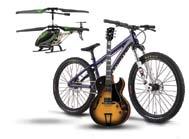




This is the fourth year of the Rare Breed Trust’s Auction a.k.a. Future Farms Fund and Genebank. Again, we are incredibly grateful to have received sponsorship and donations from all over Australia, and from far afield as Canada!
The trust is run entirely by volunteers and receives no government funding. We have tried for more than ten years to get DGR but, unfortunately, there is no category for domestic livestock.
A government round table discussion set up by David Littleproud in 2021 concluded that Australia, one of the few countries in the world that doesn’t have its own gene bank, needed one. Despite that, nothing has been done, so the RBTA took matters into its own hands and started one.
At present we have mostly cattle semen plus a bit of horse semen, and there are plans to expand on this in the future.
We have two sources of funds at the RBTA, one being membership revenue ($35 per year). We have around 100 members. The second source is this auction. All money raised goes towards the Genebank (semen storage).
If you are a business or individual and you would like to donate to our auction in the future, please do not hesitate to contact us at rbta.auction@gmail.com.
We also have corporate / business membership, also at $35 per year. We put out a wonderful publication quarterly included in your membership, Paddocks and Perches. Advertising is also available in it. You can apply online or contact us at rarebreedstrustau@gmail.com Now, to the auction
From farmers and their families to football fans, there is plenty to interest everyone!
From poultry to pigs, and English Leicester sheep to Highland ponies, there are rare treasures to be found at the auction.
It’s a bit of a family and friends affair as well. My sister-in-law artist, Barbara GibbingsBuckland, has donated some prints of rare breed cattle (White Park, now vanished in Australia), a Gloucester Old Spot pig (also sadly now lost in Australia) and a Red Cap Cock bird. Barb also did the art work on the Akubra hat last year. My sister donated some candles, my niece a canvas print and friend and well known dog trainer and trialist, Tammie Conroy, is the Auction Coordinator. Good friend Alex picked out the photo of the English Leicester flock and made it picture perfect for the other canvas. My pick? The treasure trove of our UK counterpart’s magazine, The Ark. For a book lover like me it’s the perfect prize!
Australian icon, Kent Saddlery, has donated generously to our auction since it’s inception, as have RM Williams Outback Magazine, so now’s your chance to get a handbag better than a Prada and not have to worry about calling into the newsagent to pick up the Outback mag.
Victorians can help support the trust and get themselves some AFL Golden Ticket seats at the exclusive Medallion Club. We appreciate Rob McCracken and the Farmer Direct team for donating these, as well as a subscription to the Small Farmer Magazine.
Zoos from all over Australia have donated passes and experiences once again.
Other wonderful items are a two night stay in Queensland at Glenlyon Dam donated by myself, and an unforgettable Highland cow experience in NSW.
If you are looking for feed – Riverina Warwick have come on board once again as well as Laucke Mills and Wilshire & Co have donated Agricon Blocks
We are indebted to Craig Cross who donated semen from Ravenswood Prado, a beautiful British White bull, long, well balanced and with an excellent temperament. Five straws are available. Craig has also supports our Genebank with other donations.
There will also be the absolutely amazing opportunity to start up a herd of what is possibly Australia’s most endangered breed of cattle, with only one breeder at this point in time. The Shetland breed from the Scottish isles are a beautiful catttle with a beautiful temperament. The donation consists of five straws from each of these registered Shetland bulls, born in 2015 from embryos imported from Scotland. The bulls are Zetralia Atticus and Zetralia Apollo Bay and they are registered


with the Shetland Cattle Herd Book Society in Shetland. Atticus is the one with white markings on his back, Apollo Bay is almost entirely black but with characteristic white underbelly. Both bulls are two and a half years old at the time of photography but won’t fully mature until around six years old. They are the only ones in Australia.
Five straws from each of these two bulls. They were born in Victoria in 2015 from the embryos that I flushed in Scotland. They are both from the same sire but their dams are wide apart genetically.
Shetlands are an ancient breed from the Shetland Islands to the north of Scotland and are believed to have descended from the semidomesticated aurochs introduced there 5,000 years ago. The Shetland was originally a dairy breed but from the mid 20th Century beefier examples were bred to meet the changing market. Meat and milk are both exceptional and the breed has many additional attributes that make it a valuable addition to the Australian cattle population.
If the successful bidder for the straws is interested in starting a breeding program there are straws available in Australia from sufficient additional unrelated bulls to make this a realistic undertaking. The owner of the straws would be happy to discuss this.
Just as I was about to sign off a last minute donation has come in consisting of 10 straws of Berkshire Pig Semen, donated by Linton Batt. What an amazing opportunity for someone to add genetics to their herd of pigs.
For a full list of the 53 items on offer head to RARE BREEDS TRUST OF AUSTRALIA 2024 CHARITY AUCTION - Auction 567 | AuctionsPlus.
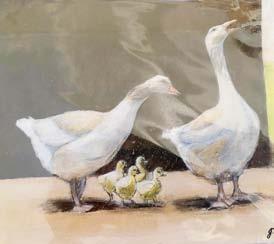

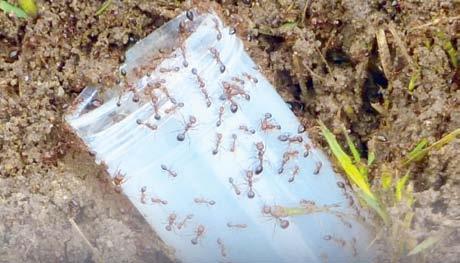

The threat of Red Imported Fire Ants is, unfortunately, lingering above our heads, or perhaps better said at our feet, with the recent discovery at Oakey.
It would be fair to say that this is a worrying development in our nation’s fight to eradicate fire ants as it means they are now beginning to march further west over the Great Dividing Range.
This is concerning for a variety of reasons, the first of which is the potential impact these
pests could have on agriculture if they were to make their way into the Murray Darling Basin.
Given their ability to survive and travel in water, it is entirely possible they could spread across the Murray Darling Basin if containment and eradication efforts are unsuccessful.
It’s been suggested that if Red Imported Fire Ants were to spread across the country it could reduce our nation’s agricultural output by up to 40 per cent costing our economy about $2 billion in the process.
That would be a devastating blow to our country.
On top of that, fire ants could threaten our
Do you have a story to tell, new
way of life if they were to spread to our lawns, our sporting fields, and parks.
These pests have the potential to deliver painful bites that in some cases have led to hospitalisation and even death in rare instances.
It is vital that we do all we can as a nation to not only contain Red Imported Fire Ants but to eradicate them.
Up to this stage, the federal Labor government has been too slow to act with The Response Plan saying in July last year that $592 million was required over the next four years to control the pest, including immediate funding
to talk
for 2023-24
Unfortunately, Labor didn’t commit to the funding until October, which led to unnecessary delays.
It took The Nationals’ calling for a Senate Inquiry for this government to finally act and it is now imperative the Australian Government responds to the Senate Inquiry report including a review of funding.
The Nationals will continue to call on this government to do the right thing and ensure every measure is taken to ensure this pest doesn’t spread across our great country.
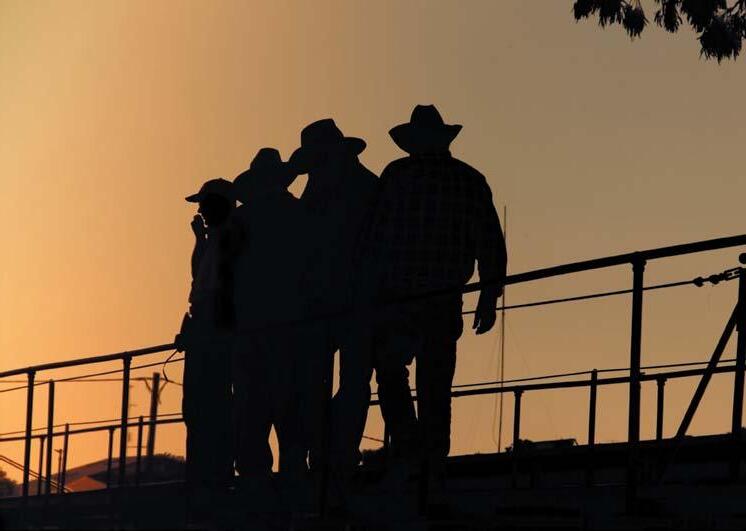
or just simply highlight an achievement....
Fiona Gowers | E: fiona.gowers@queenslandfarmertoday.com.au
Breanna Lloyd | E: breanna.lloyd@queenslandfarmertoday.com.au
For all your classified and advertising enquiries, contact our team.
Samantha Wantling
P: 0439 420 289
E: samantha.wantling@warwickstanthorpetoday.com.au
Cindy Unwin
P: 0408 281 861
E: cindy.unwin@cqtoday.com.au
Daniel Pelcl
P: 0408 956 830
E: daniel.pelcl@burnetttoday.com.au
Classified Advertising
Sharon Jones
P: 07 4182 0451
E: sharon.jones@burnetttoday.com.au
17,000 copies published. Inserted into the following newspapers:
• South Burnett Today
• Central & North Burnett Today
• Warwick Today
• Stanthorpe Today
• Leader Today
• Jimboomba Today
• Beaudesert Times
• Emerald Today
• CQ Today
• Goondiwindi Argus
Also available from the follow outlets:
• Hartleys Newsexpress Toowoomba
• Roma Sale Yards
• Warwick Sale Yards
• Highfields News & Post
• Pittsworth Newsagency
• News Extra Central City
Next Edition out on JUNE 27, 2024
Chinchilla Polocrosse Club will this month host the 2024 Australian Polocrosse Nationals.
Starting on 24 June, the biennial event will see 40 top-tier teams from Queensland, NSW, Victoria, the Northern Territory and West Australia compete for the prestigious title of the “best in Australia“.
Polocrosse - often described as rugby on horseback - is a thrilling sport that showcases horsemanship, athleticism and incredible hand-eye coordination.
Chinchilla Australian Polocrosse Nationals organising committee chair John Mullins said he was excited to bring this elite level of competition to the Western Downs region.
“To have the opportunity to showcase the best our sport has to offer to our local community and to showcase our region to the polocrosse community is a huge honour,” said Mr Mullins who has played polocrosse for 43 years.
“With just weeks to go, anticipation is building among players, families and fans alike for what promises to be an unforgettable event.
“Our club, which has about 80 active club members, is working very hard to ensure that this is the best Nationals to date.“
Not only will the region have world-class sporting action on its doorstep for seven big days, it will also benefit economically from the influx of visitors to the region.
Western Downs Regional Council spokesperson for Tourism and Recreational Spaces Councillor Kaye Maguire said the Western Downs was well-placed to host premier events.
She congratulated the Chinchilla Polocrosse Club for its success in securing the national championships.
“Major events like the Australian Polocrosse Nationals energise our economy and provide fantastic social benefits for residents and visitors alike,“ Ms Maguire said.
“Our region is a premier host destination for major sporting and cultural events and we are so thrilled to have this invaluable opportunity to promote the Western Downs and the people who make it.
“We’re excited to host the 2024 Australian Polocrosse Nationals on home soil and look forward to welcoming competitors and visitors in June.“
Every state has an opportunity to host the Nationals on a rotational basis and Polocrosse Australia president Mick Templeton knows Chinchilla will be a class act.
“Chinchilla has proven they can run fantastic large-scale events, in particular with their initiative the ‘Stud Cup’,” said Mr Templeton.
“Their facilities are excellent for players, horses and spectators so we know everyone is looking forward to descending on Chinchilla.“
While the polocrosse tournament will follow a standard formula, Chinchilla will add its own personality through live music, a mix of evening enterntainment and formal player presentation dinners for both seniors and juniors.
“It will be a night out for all the players and recognition of the teams they’re in as they’re







presented and named on stage alongside the coach and manager,“ Mr Mullins said.
“We’ve been going to the Nationals for quite a few years and taking notes.
“And (while) there’s certain protocol that
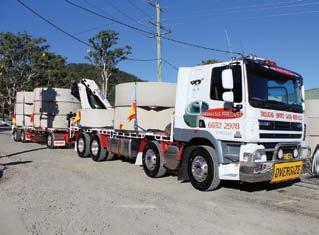

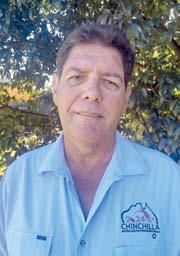
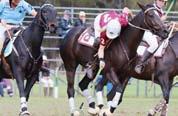
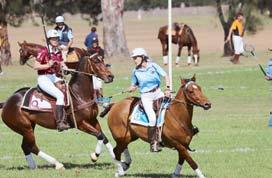
you have to follow, there’s a lot of things you can do to make your event stand out from the crowd.“
* The 2024 Chinchilla Australian Polocrosse Nationals will be held at the Chinchilla Polo-
* To keep up to date follow @auspolocrossenationals on Facebook or visit www.auspolocrossenationals.com.au